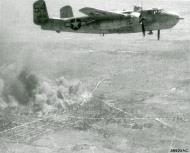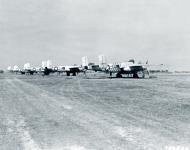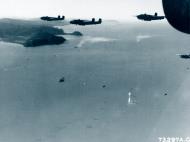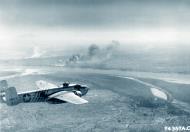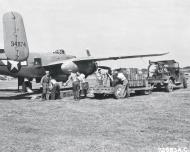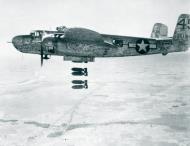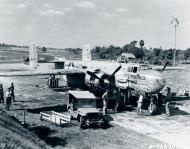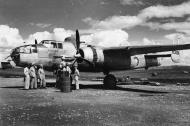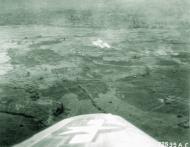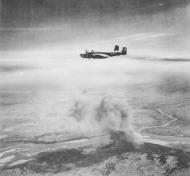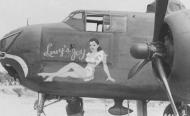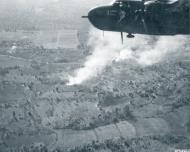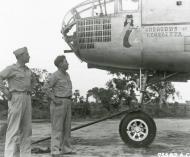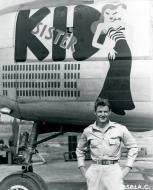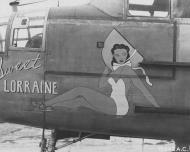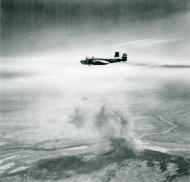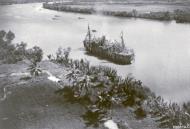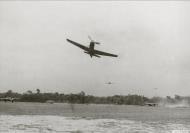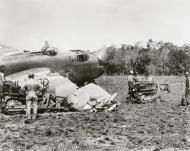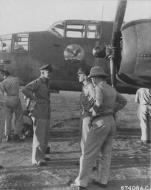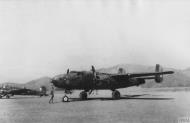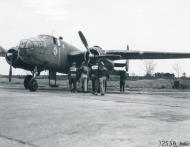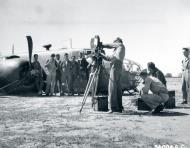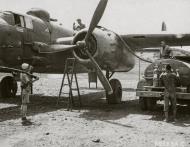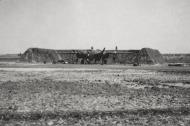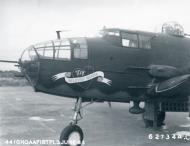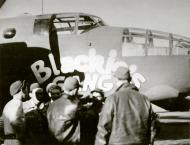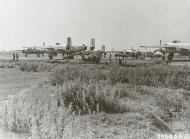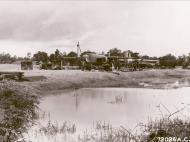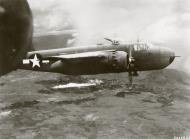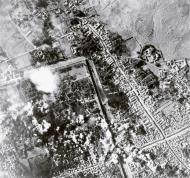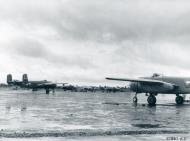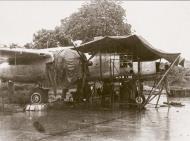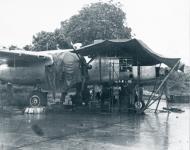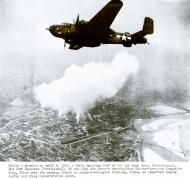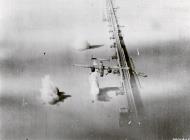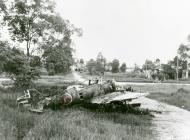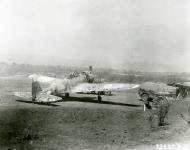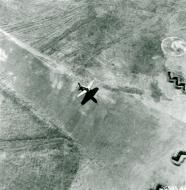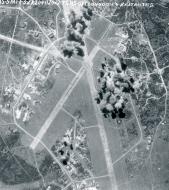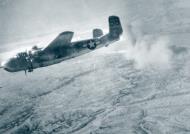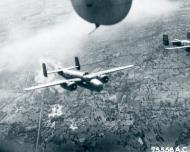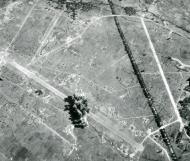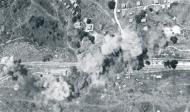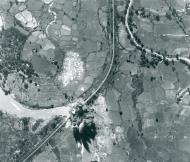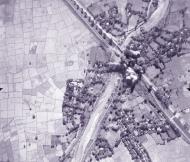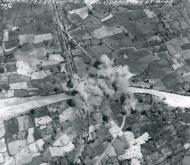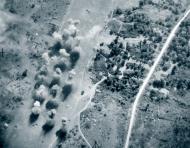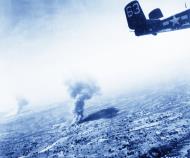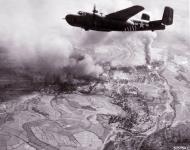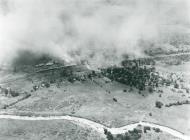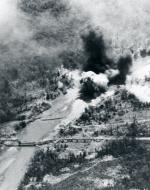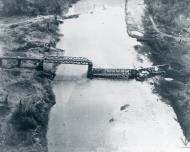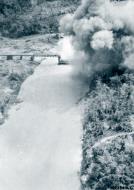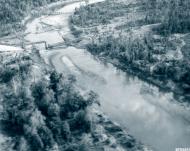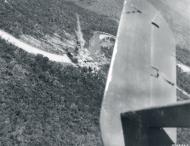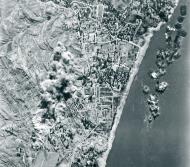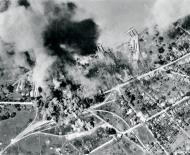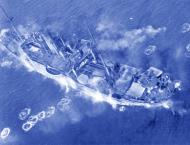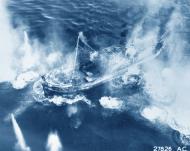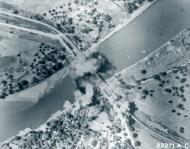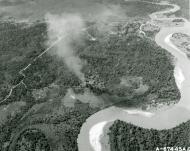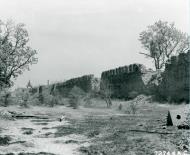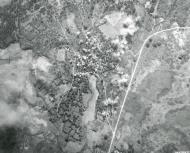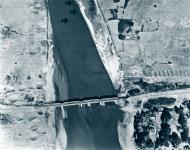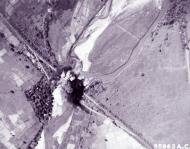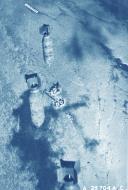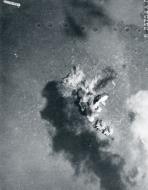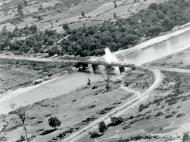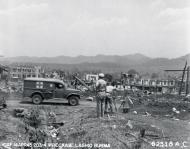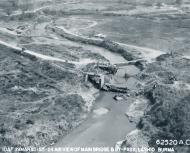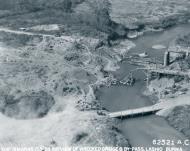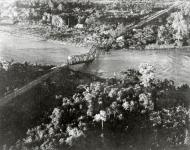China Burma India - Theater Operations - 10AF North American B-25 Mitchell photo gallery
43-4937 B-25H Mitchell 10AF 12BG81BS 25 takes off on a bombing mission 14th Nov 1944 NA201
Photo description: A North American B-25 Of The 81St Bomb Squadron, 12Th Bomb Group Takes Off On A Bombing Mission, 14 November 1944. (U.S. Air Force Number 75524AC)
Photo Source: National Archives Identifier NAID: 204959170 Local ID: 342-FH-3A33786-75524AC
43-4972 B-25H Mitchell 1ACG leaves the target area at Chauk Burma 17th Feb 1945 NA421
Photo description: A North American B-25 Leaves The Smoking Target At Chauk, Burma, 17 February 1945. (U.S. Air Force Number 74357AC)
Photo Source: National Archives Identifier NAID: 204969519 Local ID: 342-FH-3A37552-74357AC
43-5104 B-25H Mitchell 10AF 12BG81BS Bones nose art right side in India 1943 NA082
43-5104 B-25H Mitchell 10AF 12BG81BS Bones nose art right side in India 1943 NA084
Photo description: "Bones" was the last North American B-25 to come off the assembly line at North American Aviation Co's plant at Inglewood, California. Changing to a different type of production, after months of rolling out B-25's, employees covered the plane from nose to tail with their names. 81st Bomb Squadron, 12th Bomb Group, India. (U.S. Air Force Number 75537AC); (U.S. Air Force Number A75537AC)
Photo Source: National Archives Identifier NAID: 204959134 Local ID: 342-FH-3A33718-75537AC
Photo Source: National Archives Identifier NAID: 204959137 Local ID: 342-FH-3A33719-A75537AC43-5104 B-25H Mitchell 10AF 12BG81BS 45 Bones over the drop zone in Burma NA391
Photo description: The last worth American B-25 which came ofi the line of North American’s Inglewood, California, plant drops a stick of bombs on an important Japanese troop concentration and supply arsa in Central Burma, The Mitchell, now assigned to the USAAF 12th Bombardment Group, which operates in the India-Burma Theatre under Maj.Gen George K. Stratemeyer’s allied Eastern Air Command is covered over with the signatures of personnel who built it or contributed to war bonds for itfe purchase. (U.S. Air Force Number 56527AC)
Photo Source: National Archives Identifier NAID: 204968682 Local ID: 342-FH-3A37537-56527AC
Target 10AF 12BG B-25 Mitchells bomb Taungle background and Popaywan center Burma NA816
Photo description: DOUBLE—HEADER IN BURMA —— The Black Angel Squadron completes a double-header, bombing Taungle (background) and Popaywan (center), Burma. The attack destroyed 200 of Taungle’s 220 buildings, and burned out two thirds of Popayvan. It is one of a series of heavy attacks against Japanese troop concentrations, supply dumps, headquarters, defense installations, rolling stock, bridges and targets of opportunity in Central Burma by medium bombers of the 12th Bombardment Group, U.S. Army 10th Air Force, operating in the India-Burma Theatre under Major General George C. Stratemeyer's Eastern Air Command.
Photo Source: National Archives Identifier NAID: 204969306 Local ID: 342-FH-3A37786-56564AC
10AF North American B-25 Mitchell belly landed at Chakulia Airfield India NA287
Photo description: A North American B-25 crashed landed at Chakulia Airfield, India (U.S. Air Force Number 73970AC)
Photo Source: National Archives Identifier NAID: 204968544 Local ID: 342-FH-3A37478-73970AC.
10AF North American B-25 Mitchell belly landed at Chakulia Airfield India NA307
Photo description: A damaged North American B-25 of the 310th Bomb Group, considered too badly damaged for combat service, is given a complete overhauling by members of the 346th Service Squadron at Berteaux, North Africa. 5 March 1943. (U.S. Air Force Number 78953AC)
Photo Source: National Archives Identifier NAID: 204946267 Local ID: 342-FH-3A28998-78953AC
10AF North American B-25 Mitchell belly landed at Chakulia Airfield India NA307
Photo description: A damaged North American B-25 of the 310th Bomb Group, considered too badly damaged for combat service, is given a complete overhauling by members of the 346th Service Squadron at Berteaux, North Africa. 5 March 1943. (U.S. Air Force Number 78953AC)
Photo Source: National Archives Identifier NAID: 204946267 Local ID: 342-FH-3A28998-78953AC
Aerial view of the Chinese First Army engaging Jap tanks one mile north of Lashio Burma 6th Mar 1945 NA347
Photo description: Close ground-to-air contact allowed pilots to cooperate with foot soldiers and mechanized equipment in the battle for Lashio, Burma. While this Eastern Air Command USAAF aircraft circles the area, tanks of the Chinese First Army engage Jap tanks one mile north of Lashio. This kind of Air Cooperation with ground forces played a large part in the crushing blow struck at enemy resistance in North Burma. 6 March 1945 (U.S. Air Force Number 72535AC)
Photo Source: National Archives Identifier NAID: 204958312 Local ID: 342-FH-3A33865-72535AC.
B-25 Mitchell 341BG Sikh tribesman assigned guard duty based in India NA064
Photo description: Sikh tribesman guarding a North American B-25 of the 341st Bomb Group in revetment illustrates phase of reverse lend-lease. India.(U.S. Air Force Number 66967AC)
Photo Source: National Archives Identifier NAID: 204957955 Local ID: 342-FH-3A33709-66967AC
B-25 Mitchell 10AF 341BG22BS is towed from the dispersal area before taking off Chakulia India NA076
Photo description: A North American B-25 of the 22nd Bomb Squadron, 341st Bomb Group, is towed from the dispersal area over the gravel taxi strip to the concrete runway before taking off from Chakulia Airfield, India. (U.S. Air Force Number 73944AC)
Photo Source: National Archives Identifier NAID: 204957961 Local ID: 342-FH-3A33715-73944AC
B-25 Mitchell 10AF 12BG after bombing road and rail junction across the Irrawaddy River Sagaing 1944 NA795
Photo description: A U.S. Army Air Forces North American B-25 of the 12th Bombardment Group, operating in the India-Burma Theatre under the Allied Eastern Air Command, turns for home after bombing supoly areas in Sagaing, road and rail junction across the Irrawaddy River from Mandalay. Aircraft of the 12th Group, bombing from 10,000 feet, dropped more than fifty tons of incendiaries on the target, starting many fires and leaving behind them a large column of heavy white smoke. (U.S. Air Force Number 56526AC)
Photo Source: National Archives Identifier NAID: 204969558 Local ID: 342-FH-3A37775-56526AC
B-25H Mitchell named Calamity Jane nose art left side India NA603
Photo description: The Coming Monsoon Season In The India-Burma Theater, With All Its Flying Hazards, Doesn'T Worry These Eastern Air Command Pilots. Under The Watchful Eye Of 'Calamity Jane', Capt. N.W. Ryder, 813 G. St., Rupert, Idaho, Explains The Essentials Of Aural Nu (U.S. Air Force Number 59615AC)
Photo Source: National Archives Identifier NAID: 204964796 Local ID: 342-FH-3A36016-59615AC
B-25H Mitchell 1ACG Erotic Edna after attacking a bridge approaching Imphal Valley in India NA454
Photo description: The North American B-25 'Erotic Edna' Of The 1St Air Commando Force Places A Direct Hit On A Bridge Approaching Imphal Valley In India. (U.S. Air Force Number 67549AC)
Photo Source: National Archives Identifier NAID: 204969528 Local ID: 342-FH-3A37569-67549AC
B-25H Mitchells 1ACG newly assembled aircraft are lined up near Karachi India NA070
Photo description: After They Have Been Assembled, North American B-25S Designed For The 1St Air Commando Force, Are Lined Up At A Field Near Karachi, India. Note The Fighters And Light Planes In The Foreground. (Photo Taken From Top Of Hangar). (U.S. Air Force Number 67632AC)
Photo Source: National Archives Identifier NAID: 204959125 Local ID: 342-FH-3A33712-67632AC
IJAAF Nakajima Ki-43 Hayabusa or OSCAR at At Lashio Burma 11th Mar 1945 NA
Photo description: A Japanaese 'Oscar' Plame Which Was Strafed By Fighter Of The 10Th Air Force And Abandoned By The Japs At Lashio, Burma. 11 March 1945. (U.S. Air Force Number 72537AC). The Nakajima Ki-43 Hayabusa (隼, "Peregrine falcon"), formal Japanese designation Army Type 1 Fighter (一式戦闘機, Ichi-shiki sentōki) is a single-engine land-based tactical fighter used by the Imperial Japanese Army Air Service in World War II. The Allied reporting name was "Oscar", but it was often called the "Army Zero" by American pilots because it bore a certain resemblance to the Mitsubishi A6M Zero, the Imperial Japanese Navy's counterpart to the Ki-43.
Photo Source: National Archives Identifier NAID: 204959216 Local ID: 342-FH-3A34003-72537AC
Target B-25 Mitchell 10AF 12BG82BS bombing the railway yards at Pyinmana Burma 2nd Dec 1944 NA713
Photo description: Bomb Bursts Completely Cover The Railroad Yards At Pyinmana, Burma After Planes Of The 12Th Bomb Group, 434Th Bomb Squadron Have Flown Over And Dropped Their Lethal Loads On 2 December 1944. (U.S. Air Force Number 123712AC)
Photo Source: National Archives Identifier NAID: 204969549 Local ID: 342-FH-3A37732-123712AC
Target B-25 Mitchell 10AF 12BG82BS bomb Thedaw airfield Burma 12th Dec 1944 NA849
Photo description: Bombs Burst In A Compact Cluster On Thedaw Landing Ground, Burma On 12 December 1944 During A Mission By Planes Of The 12Th Bomb Group, 82Nd Bomb Squadron. (U.S. Air Force Number 123713AC)
Photo Source: National Archives Identifier NAID: 204969567 Local ID: 342-FH-3A37805-123713AC
Target B-25 Mitchell 10AF 12BG82BS bomb Thedaw airfield Burma 12th Dec 1944 NA849
Photo description: (U.S. Air Force Number 62734AC)
Photo Source: National Archives Identifier NAID: 204991847 Local ID: 342-FH-3A45999-62734AC
41-29899 B-25D Mitchell 10AF 341BG490BS Mr Jiggs landing on a strip in India 6th Dec 1942 NA125
Photo description: The lead ship of a North American B-26 fo nation of tha 341st Bomb Group, returning from a mission, peels off and lands. India. (U.S. Air Force Number 66965AC)
Photo Source: National Archives Identifier NAID: 204958020 Local ID: 342-FH-3A33743-66965AC
B 25 Mitchell 1st Air Commando Group with Capt David T Fleming crew no 20 in India 6th Dec 1943 NA1212
Photo description: India - Complete crew of a North Ameriean B-25 #40 of the 341st Bomb Group. They are, left to right, Back rows Lt. D. T. Fleming, pilot D. A. Jones, oo-pilot Lt. E. Mason, navigator (member of crew returning to States) Lt. J. H. Teasley, bombardier Front row S/Sgt. G. A. Lamor, engineer-gunner S/Sgt. Merrant, radio gunner T/Sgt. E. S. Jasecks, crew ohief Sgt. G. S. Bogner, ass't crew chief (U.S. Air Force Number 66966AC)
Photo Source: National Archives Identifier NAID: 204960980 Local ID: 342-FH-3A34789-66966AC
B 25 Mitchell 10AF 341BG being guarded by a Sikh tribesman in a revetment India NA064
Photo description: Sikh tribesman guarding a North American B-25 of the 341st Bomb Group in revetment illustrates phase of reverse lend-lease. India. (U.S. Air Force Number 66967AC)
Photo Source: National Archives Identifier NAID: 204957955 Local ID: 342-FH-3A33709-66967AC
B-25 Mitchell 341BG enroute to its next mission on the India Burmese boarder 6th Dec 1943 NA169
B-25 Mitchell 341BG enroute to its next mission on the India Burmese boarder 6th Dec 1943 NA167
Photo description: North American B-25 of the 341st Bomb Group enroute to target for the day. India. (U.S. Air Force Number 66963AC); (U.S. Air Force Number 66961AC)
Photo Source: National Archives Identifier NAID: 204958076 Local ID: 342-FH-3A33768-66963AC
Photo Source: National Archives Identifier NAID: 204958073 Local ID: 342-FH-3A33767-66961AC
B 25 Mitchell 341BG prior to take off on their next mission India Burmese boarder 6th Dec 1943 NA062
Photo description: North American B-25's of the 341st Bomb Group lined up on runway awaiting their turns before taking off on another bombing mission. India. (U.S. Air Force Number 66959AC)
Photo Source: National Archives Identifier NAID: 204957952 Local ID: 342-FH-3A33708-66959AC
41 29899 B-25D Mitchell 10AF 341BG490BS Mr Jiggs prior to take off India 6th Dec 1942 NA060
Photo description: North American B-25 of the 341st Bomb Group on taxi strip prior to take-off on another mission. India. (U.S. Air Force Number 66958AC)
Photo Source: National Archives Identifier NAID: 204957949 Local ID: 342-FH-3A33707-66958AC
Aircrew USAAF 10AF 341BG490BS just prior to their next mission India 6th Dec 1942 NA843
Aircrew USAAF 10AF 341BG490BS just prior to their next mission India 6th Dec 1942 NA338
Photo description: NA843 Officers of the 341st Bomb Group have last minute briefing concerning weather and objective prior to take-off on another mission India. (U.S. Air Force Number 66957AC); NA338 (U.S. Air Force Number 66956AC)
Photo Source: National Archives Identifier NA843 NAID: 204964650 Local ID: 342-FH-3A36152-66957AC
Photo Source: National Archives Identifier NA338 NAID: 204961925 Local ID: 342-FH-3A35118-66956AC
SUNDAY, 10 JANUARY 1943 CBI - INDIA-BURMA THEATER (10AF):
In Burma, six B-24s and B-25s jointly attack the Myitnge bridge, knocking out a span and causing considerable damage to the entire target.
10AF B-24s and B-25s Target Myitnge bridge near Mandalay Burma 10th Jan 1943 NA529
Photo description: Part of the tons of explosives being poured on the Japanese installations in Burma in the stepped up campaign of the United States Army Tenth Air Force under Brig Gen. Clayton L. Bissell have been directed at the strategic Myitnge Bridge in Burma near Mandalay, Medium bombers attacked the bridge last week (Thursday) to score two near hits. These pictures show the bridge under attack on January 10th when bombers attacked it to score three direct hit and to completely knock out one span. The accuracy of the bombing is shown in the pictures. Following this raid the Japanese started to repair the damage and on February 11 Army heavy bombers again attacked the bridge to demolish another span and damage the approaches. Last week the northern approaches to the bridge were damaged without any losses for the Tenth Air Force. The Myitnge bridge is of great importance to the Japanese since all railway and vehicular traffic from central and southern Burma to Mandalay, Lashio and Myitkyiha, all important Japanese bases, must pass over it. (U.S. Air Force Number 23271AC)
Photo Source: National Archives Identifier NAID: 204968887 Local ID: 342-FH-3A37616-23271AC
43-4380 B-25J Mitchell 1ACG Barbie III with LtCol Ralph T Smith CO at Hailakandi India NA161
43-4380 B-25J Mitchell 1ACG Barbie III with LtCol Ralph T Smith CO at Hailakandi India NA1146
Photo description: Lt. Colonel Robert T. Smith, Commanding Officer of the medium bomber squadron assigned to the 1st Air Commando Force, poses beside the North American B-25 "Barbie” at Hailakandi, India. Formerly Colonel Smith was a pilot with the American Volunteer Group in China. (U.S. Air Force Number 67645AC); (U.S. Air Force Number 50712AC)
Photo Source: National Archives Identifier NAID: 204995176 Local ID: 342-FH-3A47093-67645AC
Photo Source: National Archives Identifier NAID: 204960873 Local ID: 342-FH-3A34745-50712AC
41-29899 B-25D Mitchell 10AF 341BG490BS in flight over Burma later destroyed on take off 24th Aug 1944 NA173
Photo description: A North American B-25 rescue plane of the India-China Wing, Air Transport Command, flies over heavily wooded area somewhere in Burma, in search of any downed planes. (U.S. Air Force Number 74956AC)
Photo Source: National Archives Identifier NAID: 204958082 Local ID: 342-FH-3A33770-74956AC
B-25 Mitchell 9PRG crew carry a camera for their mission over Burma based in India NA283
Photo description: (U.S. Air Force Number 72558AC)
Photo Source: National Archives Identifier NAID: 204965223 Local ID: 342-FH-3A36320-72558AC
43-3951 B-25J Mitchell 12BG82BS 56 Cornhusker belly landed near Myitkyina Burma 1944 NA059
43-3951 B-25J Mitchell 12BG82BS 56 Cornhusker belly landed near Myitkyina Burma 1944 NA061
43-3951 B-25J Mitchell 12BG82BS 56 Cornhusker belly landed near Myitkyina Burma 1944 NA063
43-3951 B-25J Mitchell 12BG82BS 56 Cornhusker belly landed near Myitkyina Burma 1944 NA065
Photo description: Carrying his paint pail, brushes and tools, Helicopter pilot, Lt. Irvin C. Steiner, pushes through the tall grass to salvage instruments and mark the wings of the crashed North American B-25 in the background. Near Myitkyira, Burma. A member of the 10th Air Force removes useful instruments from the panelboard of crashed North American B-25 for possible salvage. Lt. Irvin C. Steiner, in the process of salvaging, notices the left engine propeller of this crashed North American B-25 "CORNHUSKER" is feathered, indicating that the pilot made his landing with one dead motor. Near Myitkyina, Burma. Lt. Irvin C. Steiner paints a large yellow cross on the wing of the crashed North American B-25 to inform new pilots flying in the area of Myitkyina, Burma, that this plane has already been reported, for salvage, to intelligence of the 10th Air Force.(U.S. Air Force Number 73324AC); (U.S. Air Force Number 73325AC); (U.S. Air Force Number 73326AC); (U.S. Air Force Number 73327AC)
Photo Source: National Archives Identifier NA059 NAID: 204966930 Local ID: 342-FH-3A36900-73324AC
Photo Source: National Archives Identifier NA061 NAID: 204966933 Local ID: 342-FH-3A36901-73325AC
Photo Source: National Archives Identifier NA063 NAID: 204966936 Local ID: 342-FH-3A36902-73326AC
Photo Source: National Archives Identifier NA065 NAID: 204966939 Local ID: 342-FH-3A36903-73327ACB-25 Mitchell 1ACG crash during emergency landing at Broadway Burma 24th Apr 1945 NA231
Photo description: B-25 Mitchell crashed on Broadway in energency landing. It is pushed and pulled by two light-weight bulldozers of the Air borne Engineers to clear the runway. (U.S. Air Force Number 50992AC)
Photo Source: National Archives Identifier NAID: 204968464 Local ID: 342-FH-3A37447-50992AC
B-25 Mitchell which ditched in a lake being salvaged in India 22nd Mar 1944 NA229
Photo description: Members of the detail were: Lt. Jackson K. Brockley, East Stroudsburg, Pa. Harold J. Zimmer (Technical representative), Los Angeles, Calif. Pvt. Douglas McCullough, Callahan, California Sgt. Charles H. Watson, Detroit, Mich. Pvt. Claude Raper, Rt. 5, Madisonville, Tenn. T/Sgt. Willie P. Malone, Andulasia, Ala. Cpl. Evan T. Edwards, Wilkes-Barre, Pa. Cpl. Clifford W. Fergusson,Plymouth, Ind. Pvt. Forrest L. Fisher, Gulfport, Miss. Pvt. Vern E. Hoffman, Estherville,Iowa Pvt. Leo C. Karaph, Monroe, Ore. Pvt. Paul W. Luellen, Winchester, In. Pvt. Elmer E. Theriault, Fitchburg, .Mass. Pvt. George 0. Trim, Florence, Miss. Pvt. liflchael J. Carzelli, Puxsutawney, Penn.
Photo Source: National Archives Identifier NAID: 204968464 Local ID: 342-FH-3A37447-50992AC
43-3950 B-25J Mitchell 10AF 12BG 30 skidded of the rwy due to rain at Pandaveswar India Jan 1944 NA279
Photo description: A North American B-25 of the 12th Bomb Group, wrecked while landing in a rain at Pandaveswar, India. The plane skidded on the wet runway, slewed sideways and came to a stop against an embankment of the far side of the spur of a railroad track a great distance from the runway. January 1944. (U.S. Air Force Number 72058AC)
Photo Source: National Archives Identifier NAID: 204968532 Local ID: 342-FH-3A37474-72058AC
42-32399 B-25C Mitchell 8PRG9PRS JO Roebuck crashed near Dum Dum India 5th Aug 1943 NA293
Photo description: Rear view of the North American B-25C (A/C No. 42-32399) which crashed 12 miles southwest of Dum Dun, India. 5 August 1943 (U.S. Air Force Number 74349AC)
Photo Source: National Archives Identifier NAID: 204968553 Local ID: 342-FH-3A37481-74349AC
43-4974 B-25H Mitchell 1ACG loading fragmentation bombs at Chittagong India 23rd Jan 1945 NA443
Photo description: G.I.'s remove crates of fragmentation bombs from the bomb trailer preparatory to loading on North American B-25 at a base in Chittagong, India. 1st Air Commando Group, 23 January 1945. (U.S. Air Force Number 72683AC)
Photo Source: National Archives Identifier NAID: 204958455 Local ID: 342-FH-3A33915-72683AC
B-25 Mitchell Rescue Unit Blackies Gang in India was shot down 10th Dec 1943 6MIA NA1138
Photo description: Rescue ship shot down 10 Dec 43 in North Burma. Capt. Porter, pilot; Lt.Spar, Co-pilot; with Maj. Dewsnup, Sgt. Uswalt and two others aboard Dec 22 1943 they are still nissing. These men in picture are EM of Rescue Unit who were working on plene 4 days before it was lost. INDIA. (U.S. Air Force Number B26785AC)
Photo Source: National Archives Identifier NAID: 204960861 Local ID: 342-FH-3A34741-B26785AC
43-4965 B-25H Mitchell 10AF 12BG 67 n 43-36066 B-25J 51 over Agnu Point Myebon Akyab Burma 12th Jan 1945 NA1384
43-4965 B-25H Mitchell 10AF 12BG 67 n 43-36066 B-25J 51 over Agnu Point Myebon Akyab Burma 12th Jan 1945 NA1384
Photo description: On 12 January 1945, three squadrons of the 12th Bomb Group (The Earthquakers) took off to support British Amphibious landings on Agnu Point on Myebon Penninsula, Southeast of Akyab, Burma. On the way to trhe target, British landing barges can be seen plowing toward the beach for their amphibious attack. Indian Navy warships nearby are laying down a barrage to protect their approach. The North American B-25’s of the 12th Bomb Group are heading for the beach positions to further neutralize them. (U.S. Air Force Number 73297AC); (U.S. Air Force Number 73298AC)
Photo Source: National Archives Identifier NAID: 204963267 Local ID: 342-FH-3A35687-73297AC
Photo Source: National Archives Identifier NAID: 204963270 Local ID: 342-FH-3A35688-73298AC
41-12492 B-25C Mitchell 10AF gives shade as crew assemble a new helicopter at Singkalling Burma 23rd Jan 1945 NA009
Photo Source: National Archives Identifier (U.S. Air Force Number A62502AC) NAID: 204963486 Local ID: 342-FH-3A35696-A62502AC
41-12492 B-25C Mitchell 10AF gives shade as crew assemble a new helicopter at Singkalling Burma 23rd Jan 1945 NA1180
Photo Source: (U.S. Air Force Number A58051AC) NAID: 204966552 Local ID: 342-FH-3A36795-A58051AC
B-25 Mitchell with improvised tarpaulin during a monsoon downpour 12th Oct 1944 NA167
Photo Source: National Archives Identifier (U.S. Air Force Number 54297AC) NAID: 204963714 Local ID: 342-FH-3A35779-54297AC
B-25 Mitchell after a bird strike which was hit by three condors over India NA557
Photo description: Ack ack and a monsoon failed to stop this North American B-25 bomber, but a vulture tried it* The plane bombed its target in Burma, got through the storm, and then was hit by the great bird, He went through the "greenhouse" (note the hole) and injured Capt. Harford J. Thiery, Jr., Hartford, Conn., the co-pilot. Capt. Thiery is shown being given first-aid by Capt. Pete Cummings, a Flight Surgeon of Washington, D. C. (right), Lt. Edward P. Schug, navigator, Chicago, 111., holding the bird with Capt, Jenks, escaped injury.(U.S. Air Force Number 54581AC)
Photo Source: National Archives Identifier NAID: 204964248 Local ID: 342-FH-3A35992-54581AC
B 25 Mitchell belly landed at Chakulia India is made into a movie by the 10th Combat Camera Unit NA273
Photo Source: National Archives Identifier (U.S. Air Force Number 74004AC) NAID: 204965208 Local ID: 342-FH-3A36315-74004AC
43-4561 B-25H Mitchell 1ACG (2nd ac) on line at Chittagong India 23rd Jan 1945 NA074
43-4574 B-25H Mitchell 1ACG (3rd ac) on line at Chittagong India 23rd Jan 1945 NA074
43-4935 B-25H Mitchell 1ACG on line at Chittagong India 23rd Jan 1945 NA074
Photo description: North American B-25's on line at a base in Chittagong, India. 1st Air Commando Group, 23 January 1945. (U.S. Air Force Number 72684AC)
Photo Source: National Archives Identifier NAID: 204959131 Local ID: 342-FH-3A33714-72684AC
B-25 Mitchell 10AF 12BG81BS Gorgeous Georgetta with Major Thompson pilot in India NA1340
Photo description: Major Thompson, Pilot (Left), And An Unidentified S/Sgt. Admire The Painting On The North American B-25 'Gorgeous Georgetta' Of The 81St Bomb Squadron, 12Th Bomb Group, Somewhere In India. (U.S. Air Force Number 75562AC)
Photo Source: National Archives Identifier NAID: 204961426 Local ID: 342-FH-3A34855-75562AC
B-25 Mitchell 10AF 12BG81BS Kid Sister with Lt Wright pilot in India NA129
Photo description: Lt. Wright, Pilot, Stands Beside His North American B-25 'Kid Sister' Of The 81St Bomb Squadron, 12Th Bomb Group Somewhere In India. (U.S. Air Force Number 75561AC)
Photo Source: National Archives Identifier NAID: 204963309 Local ID: 342-FH-3A34994-75561AC
B 25 Mitchells 3TAF Eastern Air Command lands after monsoon rains India 10th Oct 1944 NA053
Photo description: INDIA-A North American B-25 Mitchell of the Third Tactical Air Force, Eastern Air Command, lands on a water soaked runway during a heavy shower. (U.S. Air Force Number 57867AC)
Photo Source: National Archives Identifier NAID: 204957944 Local ID: 342-FH-3A33703-57867AC
43 4325 B-25J Mitchell 1ACG Burma Baby after a landing mishap at Broadway Field Burma NA271
Photo description: INDIA-A North American A North American B-25 of the 1st Air Commando Force crashed while attempting to land at Broadway Field, Burma. (U.S. Air Force Number 67543AC)
Photo Source: National Archives Identifier NAID: 204969492 Local ID: 342-FH-3A37470-67543AC
43-4329 B-25H Mitchell 1ACG Dolly after an attack on Wunto Burma NA884
Photo description: North American B-25 “Mitchell" of the 1st Air Commando Force heads for home after an attack on Wunto, Burma. (U.S. Air Force Number 67552AC)
Photo Source: National Archives Identifier NAID: 204969579 Local ID: 342-FH-3A37823-67552AC
43-4329 B-25H Mitchell 1ACG 2 Sweet Sue warms up at the end of the runway at Hailakandi India NA066
Photo description: North American B-25 "Mitchells" warm up at the end of the runway at Hailakandi, India, ready for take-off. All the fighters and fighter-borabers of the 1st Air Commando Force have the identifying mark of five white stripes around the fuselage. (U.S. Air Force Number 67566AC)
Photo Source: National Archives Identifier NAID: 204959122 Local ID: 342-FH-3A33710-67566AC
Target 10AF 12BG B-25 Mitchells support British landings at Agnu Point on Myebon Peninsula 13th Jan 1945 NA
Photo description: On 13 January 1945, three squadrons of the 12th bomb Group (The Earthquakers) took off to support British Amphibious landings on Agnu Point on Myebon Peninsula, Southeast of Akyab, India. Here, a vertical view of firebombs forming their deadly pattern along the beach positions. The Japs slit trenches may be seen through the smoke. RAF fighters came in directly behind the North American B-25'3 to strafe and lay smoke screens for the attacking British forces. The whole Allied attack was well coordinated, according to aerial observers. (U.S. Air Force Number 73299AC) Further Burma in the Arakan sector the British XV Corps extends and strenghtens the bridgehead at Myebon with landings by the 25th Indian Division.
Photo Source: National Archives Identifier NAID: 204968589 Local ID: 342-FH-3A37498-73299AC
Target 10AF B-25 Mitchell 12BG83BS leave after bombing Kinu near Akyab Burma 26th Jan 1945 NA331
Photo description: A B-25 Mitchell flies above the smoking target, a military area near Akyab, Burma, after planes of the 12th Bomb Group, 83rd Bomb Squadron dropped bombs there on 26 January 1945. (U.S. Air Force Number 3A37501)
Photo Source: National Archives Identifier NAID: 204968595 Local ID: 342-FH-3A37501-3A37501
Target 10AF 12BG B-25 Mitchells bomb Apisakan airfield Mandalay area Burma Mar 1945 NA335
Photo description: The runway at Apisakan airfield, one of the principal strips in the Mandalay area, is hit directly by bombs dropped by the Earthquakers, nickname for the Twelfth Group. (U.S. Air Force Number 59630AC)
Photo Source: National Archives Identifier NAID: 204968601 Local ID: 342-FH-3A37505-59630AC
Target 10AF and RAF bomb the bridge over Bilin river between Pegu and Martaban 13th Nov 1944 NA369
Photo description: A 590 foot toad "bridge over the Bilin River in south Burma goes ur in a hurst. The bridge, "between Pegu and Martaban, was attacked by a combined raid of RAP Liberators and 10th Air Force B-24's (U.S. Air Force Number 55615AC)
Photo Source: National Archives Identifier NAID: 204968655 Local ID: 342-FH-3A37524-55615AC
Target 10AF bomb the bridge over Bilin river between Pegu and Martaban 13th Nov 1944 NA373
Photo description: Bilin Road Bridge, Burma after bombing. This is one of three bridges between Pegu and Moulmein hit from minimum altitude on 13 Nov. 1944 by Liberators of the Strategic Air Force. One more Jap artery neatly severed. Road is important because it con be used to truck supplies from Bangkok and Ye if the rail bridges are out. (U.S. Air Force Number 56186AC)
Photo Source: National Archives Identifier NAID: 204968658 Local ID: 342-FH-3A37526-56186AC
Target 10AF bomb the rail bridge over Bilin river between Pegu and Martaban 13th Nov 1944 NA375
Photo description: Bilin Rail bridge, Burma before bombing. This is at present one of the most important spans in Burma Japs can no longer depend on Rangoon and Ye as ports, must use it to carry supplies from Bangkok. (U.S. Air Force Number 56187AC)
Photo Source: National Archives Identifier NAID: 204968661 Local ID: 342-FH-3A37527-56187AC
Target 10AF 12BG83BS bomb the Budalin rail bridge in Monywa District Sagaing 25th Sep 1944 NA383
Photo description: Bombs destroy the Budalin - 18A Railroad Bridge in Burma during a mission by planes of the 12th Bomb Group, 83rd Bonfe Squadron on 2£ September 19hh» (U.S. Air Force Number 3A37531)
Photo Source: National Archives Identifier NAID: 204968667 Local ID: 342-FH-3A37531-3A37531
Target 10AF 1ACG destroy a freight train in Burma 24th Apr 1944 NA387
Photo description: First Air Commando Force operations in Burme. A railroad train is destroyed. (U.S. Air Force Number 50724AC)
Photo Source: National Archives Identifier NAID: 204968676 Local ID: 342-FH-3A37535-50724AC
Target 10AF rail road yards in Burma NA393
Photo description: The rail road yards are in ruins, with several rail cars and one locomotive standing idle on the sidings. The main rail lines are undamaged, although the supply areas immediately adjacent to the tracks are completely destroyed. (U.S. Air Force Number 57161AC)
Photo Source: National Archives Identifier NAID: 204968676 Local ID: 342-FH-3A37535-50724AC
Target 10AF 7BG436BS B-24 Liberators bomb oil refinary at Chaukin Burma 15th Dec 1943 NA419
Target 10AF B-25 Mitchells bomb oil refinary at Chaukin Burma 17th Dec 1943 NA423
Photo description: Bombs burst on the oil refinery at Chauk, Burma during a mission by planes of the 10th Air Force's h36th Bombardment Squadron, 7th Bombardment Group on December 15, 1943 (U.S. Air Force Number 3A37551); Smoke rises from installations at Chauk, Burma, after bombing raid by North American B-25s on 17 February 1945.(U.S. Air Force Number 74358AC)
Photo Source: National Archives Identifier NAID: 204968724 Local ID: 342-FH-3A37551-3A37551
Photo Source: National Archives Identifier NAID: 204968727 Local ID: 342-FH-3A37553-74358ACTarget 10AF B-25 Mitchells bomb oil refinary at Chaukin Burma 17th Dec 1943 NA425
Target 10AF B-25 Mitchells bomb oil refinary at Chaukin Burma 17th Dec 1943 NA427
Target 10AF B-25 Mitchells bomb oil refinary at Chaukin Burma 17th Dec 1943 NA429
Target 10AF Daga river rail bridge in Sagaing area Burma 1945 NA431
Photo description: Daga Bridge, Burma before bombing. (U.S. Air Force Number 56237AC); The Bridge Butters, using the 'Erda' method knocked three spans of the Daga Bridge into the drink with a tram of 1,000 pounders released from 300 feet. In 10 months, this low-level nose-down type of attack accounted for destruction of nearly 100 Burma bridges. (U.S. Air Force Number A56237AC); (U.S. Air Force Number B56237AC);ATTACK ON JAP SUPPLY ROUTE INTO BURMA* The Dare Bridge, one of the key spans on the Bankok-Chienguai rail line, principal Jap supply route into eastern Burma and Northern Thailand, after destruction by a volunteer mission of four Seventh Bombardment Group B-24's of the Stragtegic Air Force of Major Gen. George B. Stratemeyer's Eastern Air Command.(U.S. Air Force Number 55001AC)
Photo Source: National Archives Identifier NAID: 204968730 Local ID: 342-FH-3A37554-56237AC
Photo Source: National Archives Identifier NAID: 204968733 Local ID: 342-FH-3A37555-A56237AC
Photo Source: National Archives Identifier NAID: 204968736 Local ID: 342-FH-3A37556-B56237AC
Photo Source: National Archives Identifier NAID: 204968739 Local ID: 342-FH-3A37557-55001ACTarget 10AF B-25 Mitchell's and 51FG P 40's bomb Japanese supply base at Kamaing Burma 1943 NA464
Target 10AF B-25 Mitchell's and 51FG P 40's bomb Japanese supply base at Kamaing Burma 1943 NA465
Target 10AF B-25 Mitchell's and 51FG P 40's bomb Japanese supply base at Kamaing Burma 1943 NA467
Photo description: BOMBS AWAY1. Three bombs, dropped by a North American B-25, fall toward the target Japanese supply base at Kamaing, Burma, 1943. A tall column of smoke rises from the Japanese supply base at Kamaing, Burma, as bombs, dropped by North American B-25fs and Curtiss P-40*s of the 51st Fighter Group, hit their mark. 1943.
Photo Source: National Archives Identifier (U.S. Air Force Number 55278AC) NAID: 204968780 Local ID: 342-FH-3A37575-55278AC
Photo Source: National Archives Identifier (U.S. Air Force Number 67445AC) NAID: 204968782 Local ID: 342-FH-3A37576-67445AC
Photo Source: National Archives Identifier (U.S. Air Force Number A67445AC) NAID: 204968785 Local ID: 342-FH-3A37577-A67445AC43-28154 B-25J Mitchell 10AF 12BG82BS 49 bombing Japanese supply area at Kinu Burma 12th Nov 1943 NA472
Target 10AF 12BG82BS B-25 Mitchells bomb supply area at Kinu Burma 12th Nov 1943 NA472
Target 10AF 12BG82BS B-25 Mitchells bomb supply area at Kinu Burma 12th Nov 1943 NA474
Photo description: A B-25 Mitchell flies over the smoking target, a supply area at Kinu, Burma, after planes of the 12th Bomb Group, 82nd Bomb Squadron dropped their bonbs on 12 November 1944.
Photo Source: National Archives Identifier (U.S. Air Force Number 3A37580) NAID: 204968790 Local ID: 342-FH-3A37580-3A37580
Photo Source: National Archives Identifier (U.S. Air Force Number 3A37581) NAID: 204968793 Local ID: 342-FH-3A37581-3A37581B 25 Mitchells 10AF 12BG81BS bombing marshalling yards at Kunu Burma 2th Nov 1943 NA
Photo description: A North American B-25 of the 81st Bomb Squadron, 12th Bomb Group leaves Kunu, Burma after dropping its bombs on the marshalling yards, 2 November 1944. (U.S. Air Force Number 3A37580)
Photo Source: National Archives Identifier NAID: 204968790 Local ID: 342-FH-3A37580-3A37580
Target 10AF B-25 Mitchell's bomb Kyundon Japanese supply area with houses left burning Sagaing Burma NA487
Photo description: Capture of Kyauktalon from the Japanese was greatly speeded by attacks such as this, by USAAF North American B-25's of the 12th Bomb Group, Eastern Air Command. The burning area to the right was a ferry crossing on the Irrawaddy River, about 12 miles northwest of Sagaing, in Burma. The smoke reached a height of 10,000 feet. (U.S. Air Force Number 56923AC)
Photo Source: National Archives Identifier NAID: 204968810 Local ID: 342-FH-3A37587-56923AC
Target 10AF B-25 Mitchell's bomb Lashio a Japanese supply area Shan State Burma NA504
Target 10AF B-25 Mitchell's bomb Lashio a Japanese supply area Shan State Burma NA516
Photo description: Kyundon, on the Jap supply route in central Burma, blazes during an interdiction attaok by 10th Air Force B-25 Mitchells, one of whose shadows is shown passing over the five pagodas in the lower left of the photo. (U.S. Air Force Number 59016AC);(U.S. Air Force Number 75527AC)
Photo Source: National Archives Identifier NAID: 204968813 Local ID: 342-FH-3A37588-59016AC
Photo Source: National Archives Identifier NAID: 204968867 Local ID: 342-FH-3A37609-75527ACTarget 10AF bomb damage at Lashio after being captured Shan State Burma 14th April 1945 NA508
Photo description: "Bombs away" just a few of the many high explosives that were dropped by USAAF bombers of Eastern air Command on ijashio, Burma, Prior to the fall of the City, Japanese defensive positions, supply dumps and comnmnications were unceasingly hammered, This action by 10th A.F. and 12th Bomb Group aircraft paved the way for the ground troops who were constantly, moving up for the final blow. (U.S. Air Force Number 59632AC)
Photo Source: National Archives Identifier NAID: 204968849 Local ID: 342-FH-3A37603-59632AC
Target 10AF bomb damage at Lashio after being captured Shan State Burma Mar 1945 NA510
Target 10AF bomb damage at Lashio after being captured Shan State Burma Mar 1945 NA512
Photo description: Aerial view of bomb damage to main bridge and by-pass, Lashio, Burma, 19th March 1945. (U.S. Air Force Number 62520AC);(U.S. Air Force Number 62521AC)
Photo Source: National Archives Identifier NAID: 204968858 Local ID: 342-FH-3A37606-62520AC
Photo Source: National Archives Identifier NAID: 204968861 Local ID: 342-FH-3A37607-62521ACTarget 10AF B-25 Mitchells drop 500lb bombs on river shipping on the Irrawaddy river at Mandalay 1945 NA539
Target 10AF B-25 Mitchells drop 500lb bombs on river shipping on the Irrawaddy river at Mandalay 1945 NA541
Target 10AF B-25 Mitchells drop 500lb bombs on river shipping on the Irrawaddy river at Mandalay 1945 NA543
Photo description: MAIN CAPTION: As a result of a sustained bombing campaign by the U.S. Tenth Air Force against Jap rail communications in Burma the enemy has been forced to depend more and more on river shipping for transportation of supplies. While American aerial wrecking crews continue to keep the Burma railroads in a tangle they have hit river shipping equally heavily. Here are three scenes showing the work of a North American B-25 Mitchell medium bomber on Burma's Old Man River, the Irrawaddy, at Mandalay. (3 Photos) (U.S. Air Force Number 25704AC); (U.S. Air Force Number A25704AC); (U.S. Air Force Number B25704AC)
Photo Source: NAID: 204968902 Local ID: 342-FH-3A37623-25704AC
Photo Source: National Archives Identifier NAID: 204968905 Local ID: 342-FH-3A37624-A25704AC
Photo Source: National Archives Identifier NAID: 204968908 Local ID: 342-FH-3A37625-B25704ACTarget 10AF B-25 Mitchells bomb the historic old fort at Mandalay 17th Mar 1945 NA552
Target 10AF B-25 Mitchells bomb the historic old fort at Mandalay 17th Mar 1945 NA554
Target 10AF B-25 Mitchells bomb damage to the historic old fort at Mandalay 21st Mar 1945 NA556
Photo description: Bombing of the fort at Mandalay, Burma, 17 March 1945. (U.S. Air Force Number 72741AC) (U.S. Air Force Number A72741AC); Bomb damage to the fort at Mandalay, Burma. 21 March 1945. (U.S. Air Force Number 72744AC)
Photo Source: National Archives Identifier NAID: 204968923 Local ID: 342-FH-3A37631-72741AC
Photo Source: National Archives Identifier NAID: 204968926 Local ID: 342-FH-3A37632-A72741AC
Photo Source: National Archives Identifier NAID: 204968929 Local ID: 342-FH-3A37633-72744AC43-4278 B-25H Mitchell 1ACG Satan's Sister drops incendiary over the railway junstion at Mawlu Burma NA562
Target 10AF 1ACG P-51 Mustangs under Col Philip Cochran's bomb the railway junstion at Mawlu Burma NA560
Photo description: While their big brothers in Europe smash German communications with daily blasts of high explosives, the Mitchell medium bomber and Mustang fighter-bombers of Col. Philip Cochran's Commando Force in Burma also did quite a job of behind-the-lines disrupting. Here, they have smashed a Jap rail junction at Mawlu, Burma. (U.S. Air Force Number 51505AC); NA562 A North American B-25 of the 1st Air Commando Force drops incendiary bombs as a road block Mawlu, Burma. (U.S. Air Force Number 67551AC)
Photo Source: National Archives Identifier NA560 NAID: 204968935 Local ID: 342-FH-3A37635-51505AC
Photo Source: National Archives Identifier NAID: 204968938 Local ID: 342-FH-3A37636-67551ACTarget 10AF 12BG B-25 Mitchells bomb the Kwetnge airfield Meiktila Burma NA576
Photo description: Black smoke from exploding bombs rises from the strip at Kwetnge in the Meiktila group after an attack by the Earthquakers. (U.S. Air Force Number 60136AC)
Photo Source: National Archives Identifier NAID: 204968959 Local ID: 342-FH-3A37643-60136AC
Target 10AF aircraft blanketing a Jap freighter with direct hits in the Andaman Sea at Mergui Burma NA578
Photo description: Planes of the US Army 10th Air Force give this Jap freighter at Mergui, Burma, a port on the Andaman Sea, a thorough blanketing with direct hits and hull-shattering near misses. (U.S. Air Force Number 27826AC)
Photo Source: National Archives Identifier NAID: 204968962 Local ID: 342-FH-3A37644-27826AC
Target 10AF 7BG Outlaws B-24 Liberator's hit a IJN armed merchant vessel at Mergui nr Tavoy NA
Photo description: The "Outlaws,'1 a squadron of the 7th Bombardment Group of the 10th AF flew more than twenty two hundred miles on a mission to Mergui, near Tavoy, to attack this armed Japanese merchant vessel. This ship subsequently sank. Deck level attacks of this type are routine. (U.S. Air Force Number 50760AC)
Photo Source: National Archives Identifier NAID: 204968965 Local ID: 342-FH-3A37645-50760AC
Target 10AF 1ACG under Col Philip Cochran's bomb the railway bridge at Meza Burma NA560
Target 10AF 1ACG under Col Philip Cochran's bomb the railway bridge at Meza Burma NA589
Target 10AF 1ACG under Col Philip Cochran's bomb the railway bridge at Meza Burma NA591
Target 10AF 1ACG under Col Philip Cochran's bomb the railway bridge at Meza Burma NA592
Target 10AF 1ACG under Col Philip Cochran's bomb the railway bridge at Meza Burma NA594
Photo description: MORE PHOTOS OF THE BURMA GLIDER PUSH BY COCHRAN'S AIR COMMANDOES which carried Allied troops over the Japanese lines in Northern Burma to carve air bases out of the jungles and set up a stronghold deep in the enemy's rear, from which to menace his north-south supply line. The temporary bridge at Meza, Burma rised by the Japs for communications. The original bridge destroyed some time previously, can be seen in the foreground, left. (U.S. Air Force Number 50651AC); (U.S. Air Force Number 51519AC); (U.S. Air Force Number 59386AC); (U.S. Air Force Number 67553AC);(U.S. Air Force Number 67554AC)
Photo Source: National Archives Identifier NA560 NAID: 204968970 Local ID: 342-FH-3A37647-50651AC
Photo Source: National Archives Identifier NA589 NAID: 204968979 Local ID: 342-FH-3A37650-51519AC
Photo Source: National Archives Identifier NA591 NAID: 204968982 Local ID: 342-FH-3A37652-59386AC
Photo Source: National Archives Identifier NA592 NAID: 204968984 Local ID: 342-FH-3A37653-67553AC
Photo Source: National Archives Identifier NA594 NAID: 204968987 Local ID: 342-FH-3A37654-67554ACTarget 10AF 7BG B-24's Liberators bomb jetty areas at Moulmein Port area Burma 14th April 1945 NA606
Target 10AF 7BG B-24's Liberators bomb jetty areas at Moulmein Port area Burma 14th April 1945 NA608
Photo description: 10th Air Force B-24's of the 7th Bombartment Group, operating under the Strategic Air Force of Maj. Gen. George E. Stratemeyer's Eastern Air Command, recently flew a highly successful mission against the jetty areas at Moulmein, second largest port in Burma. Supplies coming up the Burma-3iam railroad from Bangkok are ferried from Moulmein to Martaban. From there they go by rail to Rangoon and then north to Japanese forces on the various Burma fronts. These photographs were taken from the B-24’s during the raid. (U.S. Air Force Number 3A37663); (U.S. Air Force Number 55587AC)
Photo Source: National Archives Identifier NAID: 204969006 Local ID: 342-FH-3A37663-3A37663
Photo Source: National Archives Identifier NAID: 204969009 Local ID: 342-FH-3A37664-55587ACTarget 10AF B-25 Mitchells bomb the Mu River bridge at Nyaungbinwun Burma 1945 NA627
Target 10AF B-25 Mitchells hit the Mu River bridge with 1,000lb bomb Nyaungbinwun Burma 1945 NA629
Target 10AF B-25 Mitchells hit the Mu River bridge with 1,000lb bomb Nyaungbinwun Burma 1945 NA632
Photo description: The reconquest of Burma depends largely on the disruption of Japanese lines of communication and supply there, and that's why U.S. Army Air Forces planes return again and again to bomb the Mu River bridge at Nyaungbinwun. This bridge controls traffic over a 250 mile stretch of the Burma Railroad between Mandalay and Ye-U. The US public has seen photographs of the Mu River bridge destroyed in the past, but the structure had been completely rebuilt when 6 B-25 bombers of the Eastern Air Command, escorted by 16 P-38's returned to that area again early this year. It stands out sharply in this photo, nicely rebuilt by the Japanese after previous destruction by US Army Air Forces planes. The scene is serene - except for the ominous shadows in the river - three US planes swooping in for the kill.(U.S. Air Force Number 27692AC); Skimming the tree tops for better aim, a USAAF medium bomber can be seen over the Mu River Bridge, Burma, Just after dropping a 1,000-pound missile. The full force of the explosion is not yet apparent. (U.S. Air Force Number A27692AC); Two up and two down - of the bridge's 4 sections and the 2 still standing have been damaged. Again the Mu River Bridge and it's approaches have been destroyed. It will take the Japs along time to repair it. (U.S. Air Force Number B27692AC)
Photo Source: National Archives Identifier NA627 NAID: 204969024 Local ID: 342-FH-3A37678-27692AC
Photo Source: National Archives Identifier NA629 NAID: 204969027 Local ID: 342-FH-3A37679-A27692AC
Photo Source: National Archives Identifier NA631 NAID: 204969030 Local ID: 342-FH-3A37680-B27692ACTarget 10AF 12BG82BS B-25 Mitchells hit the Myittha Bridge Burma 17th Nov 1944 NA666
Photo description: Bombs hit squarely on Myittha Bridge #719, Burma after planes of the 12th Bomb Group, 82nd Bomb Squadron have emptied their bomb bays, 17 November 1944. (U.S. Air Force Number 3A37699)
Photo Source: National Archives Identifier NAID: 204969084 Local ID: 342-FH-3A37699-3A37699
Target 10AF 12BG82BS B-25 Mitchells hit railroad junction at Naba Sagaing Burma NA678
Target 10AF 12BG82BS B-25 Mitchells hit railroad junction at Naba Sagaing Burma NA680
Photo description: Japanese communications systems, railroads, bridges, river transports, and such have been under consistent attack by planes of the U.S. Tenth Air Force. These two pictures show an attack by U. S. medium bombers on the important railroad junction at Naba, through which passes much of the oil from the rich Burma fields to supply the Japanese invasion forces. (2 photos) (U.S. Air Force Number 25780AC); (U.S. Air Force Number A25780AC)
Photo Source: National Archives Identifier NAID: 204969106 Local ID: 342-FH-3A37709-25780AC
Photo Source: National Archives Identifier NAID: 204969109 Local ID: 342-FH-3A37710-A25780AC
Target 10AF 12BG83BS B-25 Mitchells hit Nattalin Railroad Bridge Burma 25th Dec 1944 NA699
Photo description: Bombs knock out the Nattalin Railroad Bridge #379 in Burma on 25th December 1944 after planes of the 12th Bomb Group, 83rd Bomb Squadron accomplished their mission. (U.S. Air Force Number 3A37724)
Photo Source: National Archives Identifier NAID: 204969140 Local ID: 342-FH-3A37724-3A37724
Target 10AF 7BG B-24 Liberators-hit-the railroad yards at Pyinmana Burma NA715
Photo description: Early in December USAAF B-24s of the Seventh Bombardment Group, Strategic Air Foce, Eastern Air Command bombed the railroad yards at Pyinmana, key rail junction on the main line between Rangoon and Mandalay, one of the principal Japanese supply routes into North Burma. This photograph shows several sticks of bombs scoring direct hits along the length of the yards. As a result of this attack the Japanese were denied the use of the yard, for a considerable period. (U.S. Air Force Number 3A37733)
Photo Source: National Archives Identifier NAID: 204969161 Local ID: 342-FH-3A37733-3A37733
43-4478 B-25H Mitchell 10AF 1ACG drops fragmentation bombs over Simpi Rallawn Burma NA802
Photo description: Prior to the invasion of the 1st Air Commando Force, North American B-25 Mitchell dropped fragmentation bombs on Simpi, Burma. (U.S. Air Force Number 67563AC)
Photo Source: National Archives Identifier NAID: 204969285 Local ID: 342-FH-3A37779-67563AC
Target 10AF B-25 Mitchells bomb the Swa river bridge SW of Myitkyina Burma NA806
Target 10AF B-25 Mitchells bomb the Swa river bridge SW of Myitkyina Burma NA808
Photo description: Bombing of the SWA RIVER BRIDGE Burma (U.S. Air Force Number 55662AC); (U.S. Air Force Number 59641AC)
Photo Source: National Archives Identifier NAID: 204969291 Local ID: 342-FH-3A37781-55662AC
Photo Source: National Archives Identifier NAID: 204969294 Local ID: 342-FH-3A37782-59641AC
43-4806 B-25H Mitchell 10AF 12BG 54 bombs Japanese supply area at Taungdwingyi Burma 11th Apr 1945 NA814
Photo description: A USAAF North American B-25 of the 12th Bomb Group, Eastern Air Command, which is continually attacking Japanese supply routes in Burma. The smoke below is rising from fires started in the town of Taungdwingyi, on the main road between Rangoon and Meiktila. (U.S. Air Force Number 56920AC); Thousand-pound bombs land directly on the Taungup road bridge, Burma, during an attack by Consolidated B-24 Liberators of the Seventh Pombardment Group. Two fifty-foot gaps were left in the bridge and the flow of Jap supplies was held up once again. The Allied aircraft of Maj. Gen. George E. Stratemeyer's Eastern Air Command have relentlessly pounded Japanese lines of communication and supply on all the Burma fronts.(U.S. Air Force Number 50299AC)
Photo Source: National Archives Identifier NAID: 204969303 Local ID: 342-FH-3A37785-56920AC
Photo Source: National Archives Identifier NAID: 204969312 Local ID: 342-FH-3A37788-50299AC
Target 10AF 12BG434BS B-25 Mitchells bomb Toungoo landing grounds Burma 20th Jan 1945 NA862
Photo description: Bombs burst on Toungoo Landing Ground, Burma on 20 January 1945 during mission by planes of the 12th Bomb Group, 434th Bomb Squadron. (U.S. Air Force Number 3A37812)
Photo Source: National Archives Identifier NAID: 204969362 Local ID: 342-FH-3A37812-3A37812
Target 10AF 1ACG B-25H Mitchells bomb Japanese supply area at Wuntou Burma 18th Mar 1944 NA
Photo description: COCHRAN'S AIR COMMANDOES MOVE BRITISH FOOT TROOPS BEHIND JAPS IN BURMA. Gliders of the 1st Air Commando Force, having made a night landing at Broadway Field, name for the rendezvous, prepare for the forward air movement under command of Maj. Gen. Orde Charles Wingate. A North American B-25 of the 1st Air Commando Force attacks Jap stores and supply depots at Wunto, Burma. 18 March 1944. (U.S. Air Force Number 50575AC)
Photo Source: National Archives Identifier NAID: 204969380 Local ID: 342-FH-3A37819-50575AC
Target 10AF 1ACG B-25 Mitchells bomb Japanese supplies at Wuntho Burma 1945 NA882
Photo description: Smoke rises after an attack on the motor pool and supply depot at Wunto, Burma, by the 1st Air Commando Force. 18 March 1944. (U.S. Air Force Number A67550AC)
Photo Source: National Archives Identifier NAID: 204969389 Local ID: 342-FH-3A37822-A67550AC
IJAAF Aichi D3A2 VAL dive bomber destroyed on the ground by 14AF fighters in China 1945 NA
Photo description: This Wrecked Japanese Plane (Val), Shows Why There Was No Resistance Given The 14Th Af, While Supporting The Chinese Ground Forces. (U.S. Air Force Number 59712AC)
Photo Source: National Archives Identifier NAID: 204833456 Local ID: 342-FH-3A02409-59712AC
IJAAF Tachikawa Ki 36 IDA at Blair Field Fort Bayard Liuchow Peninsula taken by 14AF B-25 28th Oct 1943 NA221
Photo description: The Tachikawa Ki-36 (named Ida in Allied reporting code) was a Japanese army co-operation aircraft of World War II. It was a two-seat, low-wing monoplane with a single piston engine and fixed, tailwheel-type undercarriage. The 14th Air Force also takes low level pictures. A North American B-25 took this photo of a light reconnaissance bomber on Jap-occupied Blair Field at Fort Bayard on Liuchow Peninsula of South China. This plane is probably an Ida (T.98), as is suggested by the tail assembly. Note slit trench and tripod tower set in circle. Shortly afterward, a strafing Lockheed P-38 left the plane in flames. The date was 28 October 1943. (U.S. Air Force Number 26565AC)
Photo Source: National Archives Identifier NAID: 204829381 Local ID: 342-FH-3A00916-26565AC
44-30866 B-25J Mitchell 10AF 12BG82BS Sunday Punch 1Lt Thomas Evans at Fenny India spring 1945 Eduard 0A-0B
Image description: The ship with the name Sunday Punch was purchased thanks to the fundraising campaign conducted by employees of the Oak Ridge (K-25) plant in Tennessee. The plant was part of the Manhattan Project, and when each employee donated their two Sunday overtime pay checks, $250,000 was raised - enough to buy one Mitchell. Factory representatives then christened the plane with a bottle of champagne at McGhee Tyson Airport in Knoxville on March 18, 1945, with the name SUNDAY PUNCH. The name referred to the Sunday punch card paychecks. After shipment to India, the aircraft was assigned to the 82nd BS, where the staff added a drawing of a scantily clad girl to the lettering. And when one of the pilots, 1/Lt. Thomas Evans, learned that the ship had been purchased thanks to the campaign conducted in his home state, he requested her assignment. By the end of the war, Evans had flown 14 of his 28 combat missions with her. One of these was the May 27th attack on Takli Airfield in Thailand. In poor weather conditions, they made a total of 2,580 km (1,600 miles) flight and subsequent attack.
Image Source: https://www.eduard.com/eduard/plastic-kits/limited-edition/aircraft/1-72/gunn%c2%b4s-bunny-1-72.html
China Burma India - Theater Operations - 10AF
1st Air Commando Group
1st Air Commando Group
Constituted as 1st Air Commando Group on 25 Mar 1944 and activated in India on 29 Mar. The group, which began operations immediately, was organized to provide fighter cover, bombardment striking power, and air transportation services for Wingate's Raiders, who were operating behind enemy lines in Burma. The organization consisted of a headquarters plus the following sections: bomber (equipped with B-25's); fighter (P-51's); light-plane (L-1's, L-5's, and helicopters) transport (C-47's); glider (CG-4A's and TG-5's); and light-cargo (UC-64's). The group supported operations in Burma by landing and dropping troops, food, and equipment; evacuating casualties; and attacking airfields and transportation facilities. Received a DUC for operations against the enemy, Mar-May 1944. Withdrew from the front late in May 1944 and, with the bomber section eliminated and the P-51's replaced by P-47's, began a training program. Reorganized later, with the sections being eliminated and with fighter, liaison, and troop carrier squadrons being assigned. Transported Chinese troops and supplies from Burma to China in Dec 1944, and carried out supply, evacuation, and liaison operations for Allied troops in Burma until the end of the war. Attacked bridges, railroads, barges, troop positions, oil wells, and airfields in Burma and escorted bombers to Rangoon and other targets during the early months of 1945. Changed from P-47's to P-51's in May 1945, the fighter squadrons being engaged in training from then until the end of the war. Moved to the US in Oct 1945. Inactivated on 3 Nov 1945. Disbanded on 8 Oct 1948.
Squadrons. 5th Fighter: 1944-1945. 6th Fighter: 1944-1945. 164th Liaison: 1944-1945. 165th Liaison: 1944-1945. 166th Liaison: 1944-1945. 319th Troop Carrier: 1944-1945.
Stations. Hailakandi, India, 29 Mar 1944; Asansol, India, 20 May 1944-6 Oct 1945; Camp Kilmer, NJ, 1-3 Nov 1945.
Commanders. Col Philip G Cochran, 29 Mar 1944; Col Clinton B Gaty, 20 May 1944; Col Robert W Hall, c. 7 Apr 1945-unkn.
Campaigns. India-Burma; Central Burma.
Decorations. Distinguished Unit Citation: Burma and India, [Mar 1944]-20 May 1944.
Insigne. None.
12th Bombardment Group
Constituted as 12th Bombardment Group (Light) on 20 Nov-1940. Activated on 15 Jan 1941. Trained with B-18, B-23, and PT-17 aircraft. Patrolled the west coast after the Japanese attack on Pearl Harbor. Redesignated 12th Bombardment Group (Medium) in Dec 1941. Using B-25's, began training early in 1942 for duty overseas. Moved to the Middle East, Jul-Aug 1942, and assigned to Ninth AF. Attacked storage areas, motor transports, troop concentrations, airdromes, bridges, shipping, marshalling yards, and other targets in Egypt, Libya, Tunisia, Pantelleria, Lampedusa, Crete, Sicily, and Italy, Aug 1942-Jan 1944. Supported the Allied drive from Egypt to Tunisia, Oct 1942-Apr 1943.
Early in 1943 two squadrons operated with Twelfth AF, assisting Allied forces moving eastward across North Africa, while the other squadrons continued operations with Ninth AF, bombing enemy defenses along the Mareth Line. Received a DUC for action against the enemy in North Africa and Sicily from Oct 1942 to Aug 1943. While attached to Twelfth AF, Jun-Aug 1943, the group operated from bases in Tunisia and Sicily against targets in Pantelleria, Lampedusa, Sicily, and Italy. Assigned to Twelfth AF in Aug 1943 and operated primarily against targets in Italy until Jan 1944. Flew some missions to Albania and Yugoslavia.
Moved to India, Feb-Apr 1944, and assigned to Tenth AF. Engaged chiefly in missions against the enemy in Burma, Apr 1944-May 1945. Bombed communications, military installations, and other objectives. Delivered ammunition to Allied forces at Imphal. Also attacked some targets in China. Began training with A-26 aircraft in the summer of 1945. Returned to the US, Dec 1945-Jan 1946. Inactivated on 22 Jan 1946.
Redesignated 12th Bombardment Group (Light). Activated on 19 May 1947. Not manned during 1947-1948. Inactivated on 10 Sep 1948.
Redesignated 12th Fighter-Escort Group. Activated on 1 Nov 1950. Assigned to Strategic Air Command. Trained with F-84's. Inactivated on 16 Jun 1952.
Squadrons. 81st: 1941-1946; 1947-1948. 82d: 1941-1946; 1947-1948. 83d: 1941-1946; 1947-1948. 434th (formerly 94th): 1941-1942, 1942-1946. 559th: 1950-1952. 560th: 1950-1952. 561st: 1950-1952.
Stations. McChord Field, Wash, 15 Jan 1941; Esler Field, La, c. 21 Feb-3 Jul 1942; Deversoir, Egypt, c. 31 Jul 1942; Egypt and Libya, Oct 1942; Medenine, Tunisia, 3 Apr 1943; Sfax, Tunisia, c. 15 Apr 1943; Hergla, Tunisia, 2 Jun 1943; Ponte Olivo, Sicily, c. 2 Aug 1943; Gerbini, Sicily, c. 22 Aug 1943; Foggia, Italy, c. 2 Nov 1943; Gaudo Airfield, Italy, 19 Jane Feb 1944; Tezgaon, India, c. 21 Mar 1944; Pandaveswar, India, 13 Jun 1944, Fenny, India, 16 Jul 1944; Pandaveswar, India, 8 Jun 1945; Karachi, India, 15 Nov-24 Dec 1945; Ft Lawton, Wash, 21-22 Jan 1946. Langley Field, Va, 19 May 1947-10 Sep 1948. Turner AFB, Ga, 1 Nov 1950; Bergstrom AFB, Tex, Dec 1950-16 Jun 1952.
Commanders. Unkn, Jan-May 1941; Col Charles G Goodrich, 6 May 1941; Col Edward N Backus, 16 Sep 1942; Lt Col William W Wilcox, 21 Sep 1943; Col Lloyd H Dalton Jr, c. 29 Sep 1944; Lt Col Samuel C Galbreath, 4 Sep 1945; Lt Col Lewis B Wilson, 23 Sep 1945-22 Jan 1946. Capt H Carney, Nov 1950; Col Charles A Gayle, 20 Nov 1950; Col Cy Wilson, Feb 1951; Col Charles A Gayle, Apr-16 Jun 1952.
Campaigns. Air Combat, EAME Theater; Egypt-Libya; Tunisia; Sicily; Naples-Foggia; Rome-Arno; India-Burma; China Defensive; Central Burma.
Decorations. Distinguished Unit Citation: North Africa and Sicily, Oct 1942-17 Aug 1943.
Insigne Shield: Azure, a sword point to base or, hilt flamant proper; a bordure gyronny of twelve of the second and the first. Motto: Spiritus Omnia Vincit - Spirit Conquers All. (Approved Feb 1942.)
341st Bombardment Group
Constituted as 341st Bombardment Group (Medium) on 14 Aug 1942. Activated in India on 15 Sep 1942. Equipped with B-25's. Entered combat early in 1943 and operated chiefly against enemy transportation in central Burma until 1944. Bombed bridges, locomotives, railroad yards, and other targets to delay movement of supplies to the Japanese troops fighting in northern Burma. Moved to China in Jan 1944. Engaged primarily in sea sweeps and attacks against inland shipping. Also bombed and strafed such targets as trains, harbors, and railroads in French Indochina and the Canton-Hong Kong area of China. Received a DUC for developing and using a special (glip) bombing technique against enemy bridges in French Indochina. Moved to the US in Oct 1945. Inactivated on 2 Nov 1945.
Redesignated 341st Bombardment Group (Light). Allotted to the reserve. Activated on 27 Dec 1946. Inactivated on 27 Jun 1949.
Squadrons. 10th: 1947-1949. 11th: 1942-1945. 12th: 1947-1949. 22d: 1942-1945. 490th: 1942-1945; 1947-1949. 491st: 1942-1945; 1947-1949.
Stations. Karachi, India, 15 Sep 1942; Chakulia, India, 30 Dec 1942; Kurmitola, India, Jun 1943; Kunming, China, 7 Jan 1944; Yangkai, China, 13 Dec 1944-unkn; Camp Kilmer, NJ, 1-2 Nov 1945. Westover Field, Mass, 27 Dec 1946-27 Jun 1949.
Commanders. Col Torgils G Wold, 15 Sep 1942; Col James A Philpott, 21 Sep 1943; Col Torgils G Wold, 2 Nov 1943; Col Morris F Taber, 23 Nov 1943; Col Joseph B Wells, 11 Apr 1944; Col Donald L Clark, c. 1 Dec 1944; Col James W Newsome, 16 Apr 1945-unkn.
Campaigns. India-Burma; China Defensive; China Offensive.
Decorations. Distinguished Unit Citation: French Indochina, 11 Dec 1944-12 Mar 1945.
Insigne Shield: Per fess nebuly azure and argent a semee of stars in chief of the last, over all in pale a sheathed sword proper (white, silver gray shading and deep gray outlines), the rim of the sheath and winged hilt and pommel or (outline and detail deep gray); the blade entwined with a girdle of the last; the sword point downward between two bolts of lightning radiating upward gules; over all, in base a branch of olive vert, detail vein lin or. Motto: Pax Orbis Per Arma Aeria - World Peace through Air Strength. (Approved 5 Jun 1957.)
Tenth Air Force and Fourteenth Air Force
341st Bombardment Group
Tenth Air Force (CBI), 1942-43 - Fourteenth Air Force (CBI), 1944-1945 - India, China
11th Bombardment Squadron
22d Bombardment Squadron
490th Bombardment Squadron
491st Bombardment Squadron
Inactivated Nov 1945 341st Bombardment Group
Tenth Air Force (CBI), 1942-43 - Fourteenth Air Force (CBI), 1944-1945 - India, China
Constituted as 341st Bombardment Group (Medium) on 14 Aug 1942. Activated in India on 15 Sep 1942. Equipped with B-25's. Entered combat early in 1943 and operated chiefly against enemy transportation in central Burma until 1944. Bombed bridges, locomotives, railroad yards, and other targets to delay movement of supplies to the Japanese troops fighting in northern Burma. Moved to China in Jan 1944. Engaged primarily in sea sweeps and attacks against inland shipping. Also bombed and strafed such targets as trains, harbors, and railroads in French Indochina and the Canton-Hong Kong area of China. Received a DUC for developing and using a special (glip) bombing technique against enemy bridges in French Indochina. Moved to the US in Oct 1945. Inactivated on 2 Nov 1945.
Redesignated 341st Bombardment Group (Light). Allotted to the reserve. Activated on 27 Dec 1946. Inactivated on 27 Jun 1949.
Squadrons. 10th: 1947-1949. 11th: 1942-1945. 12th: 1947-1949. 22d: 1942-1945. 490th: 1942-1945; 1947-1949. 491st: 1942-1945; 1947-1949.
Stations. Karachi, India, 15 Sep 1942; Chakulia, India, 30 Dec 1942; Kurmitola, India, Jun 1943; Kunming, China, 7 Jan 1944; Yangkai, China, 13 Dec 1944-unkn; Camp Kilmer, NJ, 1-2 Nov 1945. Westover Field, Mass, 27 Dec 1946-27 Jun 1949.
Commanders. Col Torgils G Wold, 15 Sep 1942; Col James A Philpott, 21 Sep 1943; Col Torgils G Wold, 2 Nov 1943; Col Morris F Taber, 23 Nov 1943; Col Joseph B Wells, 11 Apr 1944; Col Donald L Clark, c. 1 Dec 1944; Col James W Newsome, 16 Apr 1945-unkn.
Campaigns. India-Burma; China Defensive; China Offensive.
Decorations. Distinguished Unit Citation: French Indochina, 11 Dec 1944-12 Mar 1945.
Insigne Shield: Per fess nebuly azure and argent a semee of stars in chief of the last, over all in pale a sheathed sword proper (white, silver gray shading and deep gray outlines), the rim of the sheath and winged hilt and pommel or (outline and detail deep gray); the blade entwined with a girdle of the last; the sword point downward between two bolts of lightning radiating upward gules; over all, in base a branch of olive vert, detail vein lin or. Motto: Pax Orbis Per Arma Aeria - World Peace through Air Strength. (Approved 5 Jun 1957.)

China Burma India Theater (CBI)
China Burma India Theater (CBI) covered the following locations: China, Burma, India (also Thailand, French Indochina).
China Burma India Theater (CBI) was the United States military designation during World War II for the China and Southeast Asian or India–Burma (IBT) theaters. Operational command of Allied forces (including U.S. forces) in the CBI was officially the responsibility of the Supreme Commanders for South East Asia or China. However, US forces in practice were usually overseen by General Joseph Stilwell, the Deputy Allied Commander in China; the term 'CBI' was significant in logistical, material and personnel matters; it was and is commonly used within the US for these theaters.
U.S. and Chinese fighting forces in the CBI included the Chinese Expeditionary Force, the Flying Tigers,[1] transport and bomber units flying the Hump, including the Tenth Air Force, the 1st Air Commando Group, the engineers who built the Ledo Road, the 5307th Composite Unit (Provisional), popularly known as 'Merrill's Marauders', and the 5332d Brigade, Provisional or 'Mars Task Force', which assumed the Marauders' mission.
U.S. strategy for China
Japanese policy towards China had long been a source of international controversy. Western powers had exploited China through the open door policy, advocated by United States diplomat William Woodville Rockhill, while Japan intervened more directly, creating the puppet-state of Manchukuo. By 1937, Japan was engaged in a full-scale war of conquest in China. The infamous Rape of Nanking galvanized Western opinion and led to direct financial aid for the Kuomintang (Nationalists) and increasing economic sanctions against Japan.
In 1941, the U.S. made a series of decisions to support China in its war with Japan: Lend Lease supplies were provided after President Franklin D. Roosevelt announced the defense of China to be vital to the defense of the United States. Over the summer, as Japan moved south into French Indo-China, the U.S., Britain and the Netherlands instituted an oil embargo on Japan, cutting off 90% of its supplies. The embargo threatened the operations of the Kwantung Army, which had over a million soldiers deployed in China. Japan responded with a tightly co-ordinated offensive on 7/8 December, simultaneously attacking Pearl Harbor, the Philippines, Malaya, Singapore, Hong Kong, Guam, Wake Island, and Thailand.
Japan cut off Allied supplies to China that had been coming through Burma. China could be supplied only by flying over the Himalaya mountains ('The Hump') from India,[2] or capturing territory in Burma and building a new road—the Ledo Road.[3][4]
Burma
In 1941 and 1942, Japan was overextended. Its naval base could not defend its conquests, and its industrial base could not strengthen its navy. To cut off China from Allied aid, it went into Burma and captured Rangoon on 8 March 1942, cutting off the Burma Road. Moving north, the Japanese took Tounggoo and captured Lashio in northern Burma on 29 April. The British, primarily concerned with India, looked to Burma as the main theater of action against Japan and wanted Chinese troops to fight there.[5] The United States conjured up visions of millions of Chinese soldiers who would hold the Japanese then throw them back, while providing close-in airbases for a systematic firebombing of Japanese cities. Chinese Nationalist leader Chiang Kai-shek realized it was all fantasy. On the other hand, there were vast sums of American dollars available if he collaborated. He did so and managed to feed his starving soldiers, but they were so poorly equipped and led that offensive operations against the Japanese in China were impossible. However, Chiang did release two Chinese armies for action in Burma under Stilwell. Due to conflicts between Chiang, the British, Stilwell, and American General Claire Chennault, as well as general ill-preparedness against the more proficient Japanese army, the Burma defense collapsed. Stilwell escaped to India, but the recovery of Burma and construction of the Ledo Road to supply China became a new obsession for him.[6][7]
'On April 14, 1942, William Donovan, as Coordinator of Information (forerunner of the Office of Strategic Services), activated Detachment 101 for action behind enemy lines in Burma. The first unit of its kind, the Detachment was charged with gathering intelligence, harassing the Japanese through guerrilla actions, identifying targets for the Army Air Force to bomb, and rescuing downed Allied airmen. Because Detachment 101 was never larger than a few hundred Americans, it relied on support from various tribal groups in Burma. In particular, the vigorously anti-Japanese Kachin people were vital to the unit's success.'[8]
Detachment 101's efforts opened the way for Stilwell's Chinese forces, Wingate's Raiders, Merrill's Marauders, and the counter-attack against the Japanese Imperial life-line.[9]
Allied command structure
U.S. and Allied land forces
US forces in the CBI were grouped together for administrative purposes under the command of General Joseph 'Vinegar Joe' Stilwell. However, unlike other combat theaters, for example the European Theater of Operations, the CBI was never a 'theater of operations' and did not have an overall operational command structure. Initially U.S. land units were split between those who came under the operational command of the India Command under General Sir Archibald Wavell, as the Commander-in-Chief in India, and those in China, which (technically at least) were commanded by Generalissimo Chiang Kai-shek,[10] as the Supreme Allied Commander in China. However, Stilwell often broke the chain of command and communicated directly with the US Joint Chiefs of Staff on operational matters. This continued after the formation of the South East Asia Command (SEAC) and the appointment of Admiral Lord Mountbatten as Supreme Allied Commander.
When joint allied command was agreed upon, it was decided that the senior position should be held by a member of the British military because the British dominated Allied operations on the South-East Asian Theatre by weight of numbers (in much the same way as the US did in the Pacific Theater of Operations). Admiral Lord Mountbatten was appointed as the Supreme Allied Commander of South-East Asia forces in October 1943.
Gen. Stilwell, who also had operational command of the Northern Combat Area Command (NCAC), a US-Chinese formation, was to report in theory to Gen. George Giffard – commander of Eleventh Army Group – so that NCAC and the British Fourteenth Army, under the command of General William Slim, could be co-ordinated. However, in practice, Gen. Stilwell never agreed to this arrangement. Stilwell was able to do this because of his multiple positions within complex command structures, including especially his simultaneous positions of Deputy Supreme Allied Commander South East Asia, and Chief of Staff to Chinese leader Generalissimo Chiang Kai-shek. As SEAC's deputy leader, Stilwell was Giffard's superior, but as operational commander of NCAC, Giffard was Stilwell's superior. As the two men did not get on, this inevitably lead to conflict and confusion.
Stilwell, however, bitterly resisted [taking orders from Giffard] ... To watch Stilwell, when hard pressed, shift his opposition from one of the several strong-points he held by virtue of his numerous Allied, American and Chinese offices, to another was a lesson in mobile offensive-defence.
— William Slim[11]Eventually at a SEAC meeting to sort out the chain of command for NCAC, Stilwell astonished everyone by saying 'I am prepared to come under General Slim's operational control until I get to Kamaing'.[11] Although far from ideal, this compromise was accepted.[11]
Although Stilwell was the control and co-ordinating point for all command activity in the theater, his assumption of personal direction of the advance of the Chinese Ledo forces into north Burma in late 1943 meant that he was often out of touch with both his own headquarters and with the overall situation.[10]
Not until late 1944, after Stilwell was recalled to Washington, was the chain of command clarified. His overall role, and the CBI command, was then split among three people: Lt Gen. Raymond Wheeler became Deputy Supreme Allied Commander South East Asia; Major-General Albert Wedemeyer became Chief of Staff to Chiang Kai-shek, and commander of US Forces, China Theater (USFCT). Lt Gen. Daniel Sultan was promoted, from deputy commander of CBI to commander of US Forces, India–Burma Theater (USFIBT) and commander of the NCAC. The 11th Army Group was redesignated Allied Land Forces South East Asia (ALFSEA), and NCAC was decisively placed under this formation. However, by the time the last phase of the Burma Campaign began in earnest, NCAC had become irrelevant, and it was dissolved in early 1945.
U.S. Army and Allied Air Forces
After consultation among the Allied governments, Air Command South-East Asia was formed in November 1943 to control all Allied air forces in the theater, with Air Chief Marshal Sir Richard Peirse as Commander-in-Chief.[12] Under Peirse's deputy, USAAF Major General George E. Stratemeyer, Eastern Air Command (EAC) was organized in 1943 to control Allied air operations in Burma, with headquarters in Calcutta.[13] Unlike the strained relations and confusion encountered in coordinating Allied ground force commands, air force operations in the CBI proceeded relatively smoothly. Relations improved even further after new U.S. military aid began arriving, together with capable USAAF officers such as Brigadier General William D. Old of CGI Troop Carrier Command, and Colonels Philip Cochran and John R. Alison of the 1st Air Commando Group.[14] Within Eastern Air Command, Air Marshal Sir John Baldwin commanded the Third Tactical Air Force, originally formed to provide close air support to the Fourteenth Army. Baldwin was later succeeded by Air Marshal Sir Alec Coryton. U.S. Brigadier-General Howard C. Davidson and later Air Commodore F. J. W. Mellersh commanded the Strategic Air Force. In the new command, various units of the Royal Air Force and the U.S. Tenth Air Force worked side-by-side. In the autumn of 1943 SEAAC had 48 RAF and 17 USAAF squadrons; by the following May, the figures had risen to 64 and 28, respectively.[13]
At Eastern Air Command, Gen. Stratemeyer had a status comparable to that of Stilwell.[15] Coordinating the efforts of the various allied air components while maintaining relations with diverse command structures proved a daunting task. Part of Stratemeyer's command, the Tenth Air Force, had been integrated with the RAF Third Tactical Air Force in India in December 1943 and was tasked with a number of roles in support of a variety of allied forces. Another component, the US Fourteenth Air Force in China, was under the jurisdiction of Generalissimo Chiang Kai-shek as China theater commander. Although the India-China Division of the AAF's Air Transport Command received its tonnage allocations from Stratemeyer as Stilwell's deputy, ICD reported directly to Headquarters ATC in Washington, D.C.
In the spring of 1944, with the arrival of command B-29s in the theater, another factor would be added to air force operations. XX Bomber Command of the Twentieth Air Force was tasked with the strategic bombing of Japan under Operation Matterhorn, and reported directly to the JCS in Washington, D.C. However, XX Bomber Command remained totally dependent on Eastern Air Command for supplies, bases, ground staff, and infrastructure support.
After a period of reshuffling, Eastern Air Command's air operations began to show results. In August 1944, Admiral Mountbatten noted in a press conference that EAC fighter missions had practically swept the Japanese air force from Burmese skies. Between the formation of SEAAC in November 1943, and the middle of August 1944, American and British forces operating in Burma destroyed or damaged more than 700 Japanese aircraft with a further 100 aircraft probably destroyed.[16] This achievement considerably reduced dangers to Air Transport Command cargo planes flying in support of the Hump airlift operation. By May 1944, EAC resupply missions in support of the Allied ground offensive had carried 70,000 tons of supplies and transported a total of 93,000 men, including 25,500 casualties evacuated from the battle areas. These figures did not include tonnage flown in the Hump airlift missions to China.[16]
USAAF Order of Battle
Tenth Air Force
- 1st Air Commando Group (1944–1945)
Burma, India (B-25, P-51, P-47, C-47)- 1st Combat Cargo Group (1944–1945)
Burma, India, China (C-47, C-46).- 2nd Air Commando Group (1944–1945)
Burma, India (P-51, C-47)- 3d Combat Cargo Group (1944–1945)
Burma, India (C-47).- 4th Combat Cargo Group (1944–1945)
Burma, India (C-47, C-46).- 7th Bombardment Group (1942–1945)
India (B-17, B-24).- 12th Bombardment Group (1944–1945)
India (B-25).- 33d Fighter Group (1944–1945)
India (P-38, P-47)- 80th Fighter Group (1943–1945)
India, Burma (P-38, P-40, P-47)Transferred in 1944 to Fourteenth Air Force:
- 311th Fighter Group (1943–1944)
India, Burma (A-36, P-51)- 341st Bombardment Group (1943–1944)
India, Burma (B-25)- 443d Troop Carrier Group (1944–1945)
India (C-47/C-53)- 426th Night Fighter Squadron (1944)
India (P-61)- 427th Night Fighter Squadron (1944)
India (P-61)
Fourteenth Air Force
68th Composite Wing
- 23d Fighter Group (1942–1945) (P-40, P-51)
Formerly American Volunteer Group (AVG) "Flying Tigers".69th Composite Wing
- 51st Fighter Group: 1942–1945 (P-40, P-38, P-51).
- 341st Bombardment Group 1944–1945 (B-25).
312th Fighter Wing
- 33rd Fighter Group: 1944 (P-38, P-47).
- 81st Fighter Group: 1944–1945 (P-40, P-47).
- 311th Fighter Group: 1944–1945 (A-36, P-51).
Chinese-American Composite Wing (Provisional) (1943–1945)
- 3rd Fighter Group (Provisional) (P-40, P-51)
- 5th Fighter Group (Provisional) (P-40, P-51)
- 1st Bombardment Group (Medium, Provisional) (B-25)
Other assigned units:
- 402d Fighter Group:
May – July 1943. Assigned but never equipped.- 476th Fighter Group:
May – July 1943. Assigned but never equipped.- 308th Bombardment Group:(B-24)
March 1943 – February 1945From Tenth Air Force in 1944–1945:
- 341st Bombardment Group: (B-25)
January 1944 – November 1945- 443d Troop Carrier Group: (C-47/C-54)
Aug – November 1945- 426th Night Fighter Squadron: P-61)
1944 – 1945- 427th Night Fighter Squadron: (P-61)
1944 – 1945
Twentieth Air Force
(Attached To CBI 1944–1945)
- XX Bomber Command (1944–45)
(Kharagpur, India)
- 1st Photo Squadron
- 58th Bombardment Wing
(Chakulia, Kharagpur, Hijli AB, India) (B-29)
- 40th Bombardment Group
- 444th Bombardment Group
- 462d Bombardment Group
- 468th Bombardment Group
Twentieth Air Force XX Bomber Command (XX BC) combat elements moved in the summer of 1944 from the United States to India where they engaged in very-long-range Boeing B-29 Superfortress bombardment operations against Japan, Formosa, China, Indochina and Burma. While in India, XX BC was supported logistically by Tenth Air Force and the India-China Division of the Air Transport Command. B-29 groups moved to West Field, Tinian, in early 1945.
Timeline
Early 1942 Stilwell was promoted to lieutenant general and tasked with establishing the CBI.
25 February 1942 Stilwell arrived in India by which time Singapore and Burma had both been invaded by the Japanese Army.
10 March 1942 Stilwell is named Chief of Staff of Allied armies in the Chinese theatre of operations.
19 March 1942 Stilwell's command in China is extended to include the Chinese 5th and 6th Armies operating in Burma after Chiang Kai-shek gave his permission.
20 March 1942 Chinese troops under Stilwell engage Japanese forces along the Sittang River in Burma.
9 April 1942 Claire Chennault inducted into U.S. Army as a colonel, bringing the AVG Flying Tigers squadrons under Stilwell's nominal authority.
16 April 1942 7,000 British soldiers, and 500 prisoners and civilians were encircled by the Japanese 33rd Division at Yenangyaung.
19 April 1942 The 113th Regiment of the Chinese Expeditionary Force's New 38th Division led by General Sun Li-jen attacked and defeated the encircling Japanese troops rescuing the encircled British troops and civilians. This is historically called Battle of Yenangyaung.
2 May 1942 The commander of Allied forces in Burma, General Harold Alexander, ordered a general retreat to India. Stilwell left his Chinese troops and began the long evacuation with his personal staff (he called it a 'walk out') to India. Most of the Chinese troops, who were supposed to be under Stilwell's command, were deserted in Burma without knowledge of the retreat. Under Chiang Kai-shek they made a hasty and disorganised retreat to India. Some of them tried to return to Yunnan through remote mountainous forests and out of these, at least half died.
24 May 1942 Stilwell arrived in Delhi.
New Delhi and Ramgarh became the main training centre for Chinese troops in India. Chiang Kai-shek gave Stilwell command of what was left of the 22nd and 38th Divisions of the Chinese Army. 1 December 1942 British General Sir Archibald Wavell, as Allied Supreme Commander South East Asia, agreed with Stilwell to make the Ledo Road an American operation.[17] August 1943 US creates a jungle commando unit, similar to the Chindits, to be commanded by Major General Frank Merrill; it is informally called 'Merrill's Marauders'.[18] Exhaustion and disease led to the early evacuation of many Chinese and American troops before the coming assault on Myitkyina.[19]
21 December Stilwell assumed direct control of operations to capture Myitkyina, having built up forces for an offensive in Northern Burma.
24 February 1944 Merrill's Marauders, attacked the Japanese 18th Division in Burma. This action enabled Stilwell to gain control of the Hakawing Valley.
17 May 1944 British general Slim in command of the Burma Campaign handed control of the Chindits to Stilwell.
17 May 1944 Chinese troops, with the help of Merrill's Marauders, captured Myitkina airfield.
3 August 1944 Myitkina fell to the Allies. The Marauders had advanced 750 miles and fought in five major engagements and 32 skirmishes with the Japanese Army. They lost 700 men, only 1,300 Marauders reached their objective and of these, 679 had to be hospitalized. This included General Merrill who had suffered a second-heart attack before going down with malaria.
Some time before 27 August 1944, Mountbatten supreme allied commander (SEAC) ordered General Stilwell to evacuate all the wounded Chindits.
During 1944 the Japanese in Operation Ichi-Go overran US air bases in eastern China. Chiang Kai-shek blamed Stilwell for the Japanese success, and pressed the US high command to recall him. October 1944 Roosevelt recalled Stilwell, whose role was split (as was the CBI): Lieutenant General Raymond Wheeler became Deputy Supreme Allied Commander South East Asia. Major General Albert Wedemeyer became Chief of Staff to Chiang Kai-shek and commander of the U.S. Forces, China Theater (USFCT).[20] Lieutenant General Daniel Sultan was promoted from deputy commander to become commander of US Forces India-Burma Theater (USFIBT) and commander of the Northern Combat Area Command
12 January 1945, the first convoy over the Ledo Road of 113 vehicles led by General Pick from Ledo reached Kunming, China on 4 February 1945. Over the next seven months 35,000 tons of supplies in 5,000 vehicles were carried along it.[5]
North American B-25H MitchellSpecifications (B-25H)
Data from United States Military Aircraft since 1909[51] Jane's Fighting aircraft of World War II[52]
General characteristics
Crew: 5 (one pilot, navigator/bombardier, turret gunner/engineer, radio operator/waist gunner, tail gunner)
Length: 52 ft 11 in (16.13 m)
Wingspan: 67 ft 7 in (20.60 m)
Height: 16 ft 4 in (4.98 m)
Wing area: 618 sq ft (57.4 m2)
Airfoil: root: NACA 23017; tip: NACA 4409R[52]
Empty weight: 19,480 lb (8,836 kg)
Max takeoff weight: 35,000 lb (15,876 kg)
Powerplant: 2 × Wright R-2600-92 Twin Cyclone 14-cylinder two-row air-cooled radial piston engines, 1,700 hp (1,300 kW) eachPerformance
Maximum speed: 272 mph (438 km/h, 236 kn) at 13,000 ft (4,000 m)
Cruise speed: 230 mph (370 km/h, 200 kn)
Range: 1,350 mi (2,170 km, 1,170 nmi)
Service ceiling: 24,200 ft (7,400 m)Armament
Guns: 12–18 × .50 in (12.7 mm) machine guns and 75 mm (2.95 in) T13E1 cannon
Hardpoints: 2,000 lb (900 kg) ventral shackles to hold one external Mark 13 torpedo[53]
Rockets: racks for eight 5 in (127 mm) high velocity aircraft rockets (HVAR)
Bombs: 3,000 lb (1,360 kg) bombsAvionics
not known
- B-25 Mitchell
IL-2 Sturmovik 'Cliff's of Dover' Blitz - has no 3D model
IL-2 Sturmovik Battle of Normandy
DCS World - has no 3D model
Pandaveswar India Map
Karachi South Karachi City, Sindh Pakistan Map
Pacific Ocean theater of World War II Citations
- Cressman 2000, p. 84.
- Potter & Nimitz 1960, p. 717.
- Potter & Nimitz 1960, pp. 759–60.
- Silverstone 1968, pp. 9–11.
- Potter & Nimitz 1960, pp. 651–62.
- Kafka & Pepperburg 1946, p. 185.
- Potter & Nimitz 1960, p. 751.
- Ofstie 1946, p. 194.
- Potter & Nimitz 1960, p. 761.
- Potter & Nimitz 1960, p. 765.
- Potter & Nimitz 1960, p. 770.
- Ofstie 1946, p. 275..
Pacific Ocean theater of World War II Bibliography:
- Cressman, Robert J. (2000), The Official Chronology of the U.S. Navy in World War II, Annapolis, MD: Naval Institute Press, ISBN 1-55750-149-1.
- Drea, Edward J. (1998), In the Service of the Emperor: Essays on the Imperial Japanese Army, NB: University of Nebraska Press, ISBN 0-8032-1708-0.
- Hakim, Joy (1995), A History of Us: War, Peace and All That Jazz, New York: Oxford University Press, ISBN 0-19-509514-6.
- Kafka, Roger; Pepperburg, Roy L. (1946), Warships of the World, New York: Cornell Maritime Press.
- Miller, Edward S. (2007), War Plan Orange: The U.S. Strategy to Defeat Japan, 1897–1945, US Naval Institute Press, ISBN 978-1-59114-500-4.
- Ofstie, Ralph A. (1946). The Campaigns of the Pacific War. Washington, DC: United States Government Printing Office..
- Potter, E. B.; Nimitz, Chester W. (1960), Sea Power, Prentice-Hal.
- Silverstone, Paul H. (1968), U.S. Warships of World War II, Doubleday & Co.
- Toll, Ian W. (2011). Pacific Crucible: War at Sea in the Pacific, 1941–1942. New York: W. W. Norton.
- The Conquering Tide: War in the Pacific Islands, 1942–1944. New York: W. W. Norton.
- Twilight of the Gods: War in the Western Pacific, 1944–1945. New York: W. W. Norton.
Fifth Air Force Bibliography:
- Bartsch, William H. Doomed at the Start: American Pursuit Pilots in the Philippines, 1941–1942. Reveille Books, 1995. ISBN 0-89096-679-6.
- Birdsall, Steve. Flying Buccaneers: The Illustrated History of Kenney's Fifth Air Force. New York: Doubleday & Company, 1977. ISBN 0-385-03218-8.
- Craven, Wesley F. and James L. Cate. The Army Air Forces in World War II. Chicago: University of Chicago Press, 1948–58.
- Holmes, Tony. "Twelve to One": V Fighter Command Aces of the Pacific. Botley, Oxford, UK: Osprey Publishing, 2004. ISBN 1-84176-784-0.
- Rust, Kenn C. Fifth Air Force Story...in World War II. Temple City, California: Historical Aviation Album, 1973. ISBN 0-911852-75-1.
Notes on the North American B-25 Mitchell
- This number does not include aircraft built after World War II.
- The maximum on RAF strength was 517 in December 1944
Citations on the North American B-25 Mitchell
- 'North American B-25B Mitchell.' U.S. Air Force.
- United Press, 'Bomber Named For Mitchell', The San Bernardino Daily Sun, San Bernardino, California, Friday 23 January 1942, Volume 48, page 21.
- Baugher, Joe. 'North American B-25 Mitchell.' American Military Aircraft: US Bomber Aircraft, 6 March 2000.
- Chorlton Aeroplane May 2013, p. 74.
- 'T-6/SNJ/HVD Information (Ray) - NATA'. flynata.org.
- Parker 2013, pp. 77–79, 83, 88, 92.
- Borth 1945, pp. 70, 92, 244.
- Herman 2012, pp. 11, 88, 115, 140–143, 263, 297.
- Johnson, E. R. (2015). American Military Training Aircraft: Fixed and Rotary-Wing Trainers Since 1916. McFarland. p. 162. ISBN 9780786470945.
- Norton 2012, p. 68.
- Pace, 2002 p23
- Pace 2002, p. 6.
- '340th Bomb Group History'. 57thbombwing.com.
- Merriam, Ray, ed. 'U. S. Warplanes of World War II.' World War II Journal, No. 15, 1 July 2000, p. 8.
- Kinzey 1999, pp. 51, 53.
- Yenne 1989, p. 40.
- Kinzey 1999, pp. 52–53.
- Baugher, Joe. North American B-25H Mitchell.' American Military Aircraft: US Bomber Aircraft, 11 March 2000.
- Tallman 1973, pp. 216, 228.
- Higham 1975, 8; Higham 1978, 59.
- 'A Brief history of the B-25.' Archived 3 March 2015 at the Wayback Machine USAF.com. Accessed: 25 May 2015.
- 'Doolittle Park Will Have AF B-25 Bomber'. Playground News (Fort Walton Beach, Florida), Volume 15, Number 7, 10 March 1960, p. 10.
- 'B-25 Makes Last Flight During Ceremony at Eglin'. Playground News (Fort Walton Beach, Florida), Volume 15, Number '17' (actually No. 18: Special), 26 May 1960, p. 2.
- 'B-25 44-330854.' warbirdregistry.org. Retrieved: 30 December 2009.
- 'Closing In: Marines in the Seizure of Iwo Jima (Assault Preparations)'. www.nps.gov.
- 'Smash Hits.' Popular Mechanics, March 1947, p. 113.
- Skaarup 2009, pp. 333–334.
- Walker, R.W.R. 'RCAF 5200 to 5249, Detailed List.' Canadian Military Aircraft Serial Numbers, 25 May 2013.
- Hardesty, Von (1982). Red Phoenix: The Rise of Soviet Air Power 1941-1945. Washington, D. C.: Smithsonian Institution Press. p. 253. ISBN 0874745101.
- Glantz, David (2005). Companion to Colossus Reborn: Key Documents and Statistics. United States of America: University Press of Kansas. p. 148. ISBN 0700613595.
- Jowett, Philip (2016). Modern African Wars (5): The Nigerian-Biafran War 1967-70. Oxford: Osprey Publishing Press. p. 18. ISBN 978-1472816092.
- Dorr Wings of Fame Volume 3, p. 124.
- 'Factsheets: North American B-25.' National Museum of the United States Air Force, 26 June 2009.
- 'Factsheets: North American B-25A'. National Museum of the U.S. Air Force, 26 June 2009.
- Dorr Wings of Fame Volume 3, pp. 125–126.
- 'Factsheets: North American B-25B.' National Museum of the U.S. Air Force, 26 June 2009.
- Robison, Tom. 'B-29 in Weather Reconnaissance.' Aerial Weather Reconnaissance Association: Hurricane Hunters.
- Gibbins, Scott and Jeffrey Long. 'The History of the Hurricane Hunters.' Archived 12 September 2010 at the Wayback Machine Hurricane Hunters Association.
- Drucker, Graham.'North American B-25 Mitchell.' fleetairarmarchive.net.
- 'B-25J-30-NC SN 44-31173 'Huaira Bajo''. The B-25 History Project
- Chorlton Aeroplane May 2013, p. 85.
- Chorlton Aeroplane May 2013, p. 86.
- Hagedorn Air Enthusiast May/June 2003, pp. 53–54.
- Hagedorn Air Enthusiast May/June 2003, p. 55.
- Leeuw, Ruud. 'Cuatro Vientos – Madrid.' ruudleeuw.com.
- Hardesty 1991, p. 253.
- 'Mitchells: The North American Mitchell in Royal Air Force service.' Aeromilitaria (Air-Britain Historians), Issue 2, 1978, pp. 41–48.
- Roberts, William.'ESB News.' Elevator World, March 1996.
- Kingwell 2007, p. 12.
- Fonton, Mickaël (5 August 2010). 'Les morts mystérieuses : 4. Leclerc, l'énigme du 13e passager'. Valeurs actuelles (in French).
- Swanborough and Bowers 1963, p. 359.
- Lednicer, David. 'The Incomplete Guide to Airfoil Usage'. m-selig.ae.illinois.edu.
- Caiden 1957, p. 176.
Bibliography on the North American B-25 Mitchell: +
- Borth, Christy. Masters of Mass Production. Indianapolis, Indiana: Bobbs-Merrill Co., 1945.
- Bridgman, Leonard, ed. 'The North American Mitchell.' Jane's Fighting Aircraft of World War II. London: Studio, 1946. ISBN 1-85170-493-0.
- Caidin, Martin. Air Force. New York: Arno Press, 1957.
- Chorlton, Martyn. 'Database: North American B-25 Mitchell'. Aeroplane, Vol. 41, No. 5, May 2013. pp. 69–86.
- Dorr, Robert F. 'North American B-25 Variant Briefing'. Wings of Fame, Volume 3, 1996. London: Aerospace Publishing. ISBN 1-874023-70-0. ISSN 1361-2034. pp. 118–141.
- Green, William. Famous Bombers of the Second World War. New York: Doubleday & Company, 1975. ISBN 0-385-12467-8.
- Hagedorn, Dan. 'Latin Mitchells: North American B-25s in South America, Part One'. Air Enthusiast No. 105, May/June 2003. pp. 52–55. ISSN 0143-5450
- Hagedorn, Dan. 'Latin Mitchells: North American B-25s in South America, Part Three'. Air Enthusiast Mo. 107, September/October 2003. pp. 36–41. ISSN 0143-5450
- Hardesty, Von. Red Phoenix: The Rise of Soviet Air Power 1941–1945. Washington, D.C.: Smithsonian Institution, 1991, first edition 1982. ISBN 0-87474-510-1.
- Heller, Joseph. Catch 22. New York: Simon & Schuster, 1961. ISBN 0-684-83339-5.
- Herman, Arthur. Freedom's Forge: How American Business Produced Victory in World War II, New York: Random House, 2012. ISBN 978-1-4000-6964-4.
- Higham, Roy and Carol Williams, eds. Flying Combat Aircraft of USAAF-USAF (Vol. 1). Andrews AFB, Maryland: Air Force Historical Foundation, 1975. ISBN 0-8138-0325-X.
- Higham, Roy and Carol Williams, eds. Flying Combat Aircraft of USAAF-USAF (Vol. 2). Andrews AFB, Maryland: Air Force Historical Foundation, 1978. ISBN 0-8138-0375-6.
- Johnsen, Frederick A. North American B-25 Mitchell. Stillwater, Minnesota: Voyageur Press, 1997. ISBN 0-933424-77-9.
- Kingwell, Mark. Nearest Thing to Heaven: The Empire State Building and American Dreams. New Haven, Connecticut: Yale University Press, 2007. ISBN 978-0-300-12612-9.
- Kinzey, Bert. B-25 Mitchell in Detail. Carrollton, Texas: Squadron/Signal Publications Inc., 1999. ISBN 1-888974-13-3.
- Kit, Mister and Jean-Pierre De Cock. North American B-25 Mitchell (in French). Paris, France: Éditions Atlas, 1980.
- McDowell, Ernest R. B-25 Mitchell in Action (Aircraft number 34). Carrollton, Texas: Squadron/Signal Publications Inc., 1978. ISBN 0-89747-033-8.
- McDowell, Ernest R. North American B-25A/J Mitchell (Aircam No.22). Canterbury, Kent, UK: Osprey Publications Ltd., 1971. ISBN 0-85045-027-6.
- Mizrahi, J.V. North American B-25: The Full Story of World War II's Classic Medium. Hollywood, California: Challenge Publications Inc., 1965.
- Norton, Bill. American Bomber Aircraft Development in World War 2. Hersham, Surrey, UK: Midland Publishing, 2012. ISBN 978-1-85780-330-3.
- Pace, Steve. B-25 Mitchell Units in the MTO. Oxford, UK: Osprey Publishing, 2002. ISBN 978-1-84176-284-5.
- Pace, Steve. Warbird History: B-25 Mitchell. St. Paul, Minnesota: Motorbooks International, 1994. ISBN 0-87938-939-7.
- Parker, Dana T. Building Victory: Aircraft Manufacturing in the Los Angeles Area in World War II. Cypress, California: Dana Parker Enterprises, 2013. ISBN 978-0-9897906-0-4.
- 'Pentagon Over the Islands: The Thirty-Year History of Indonesian Military Aviation'. Air Enthusiast Quarterly (2): 154–162. n.d. ISSN 0143-5450.
- Powell, Albrecht. 'Mystery in the Mon'. Archived 31 December 2015 at the Wayback Machine 1994
- Reinhard, Martin A. (January–February 2004). 'Talkback'. Air Enthusiast. No. 109. p. 74. ISSN 0143-5450.
- Scutts, Jerry. B-25 Mitchell at War. London: Ian Allan, 1983. ISBN 0-7110-1219-9.
- Scutts, Jerry. North American B-25 Mitchell. Ramsbury, Marlborough, Wiltshire, UK: Crowood Press, 2001. ISBN 1-86126-394-5.
- Skaarup, Harold A. Canadian Warplanes. Bloomington, Indiana: IUniverse, 2009. ISBN 978-1-4401-6758-4.
- Swanborough, F.G. and Peter M. Bowers. United States Military Aircraft since 1909. London: Putnam, 1963.
- Swanborough, Gordon. North American, An Aircraft Album No. 6. New York: Arco Publishing Company Inc., 1973. ISBN 0-668-03318-5.
- Tallman, Frank. Flying the Old Planes. New York: Doubleday and Company, 1973. ISBN 978-0-385-09157-2.
- Vernon, Jerry (Winter 1993). 'Talkback'. Air Enthusiast. No. 52. pp. 78–79. ISSN 0143-5450.
- Wolf, William. North American B-25 Mitchell, The Ultimate Look: from Drawing Board to Flying Arsenal. Atglen, Pennsylvania: Schiffer Publishing, 2008. ISBN 978-0-7643-2930-2.
- Yenne, Bill. Rockwell: The Heritage of North American. New York: Crescent Books, 1989. ISBN 0-517-67252-9.
Web References on the North American B-25 Mitchell: +
- 13th Bombardment Squadron http://www.3rdattackgroup.org/13th.php
- Wikipedia.org - https://en.wikipedia.org/wiki/North_American_B-25_Mitchell

 Editor for Asisbiz: Matthew Laird Acred
Editor for Asisbiz: Matthew Laird Acred
If you love our website please donate so we can make this site even better !!




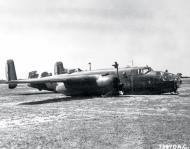
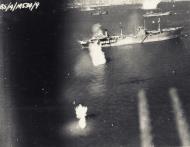

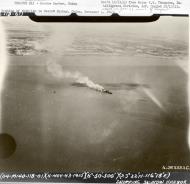
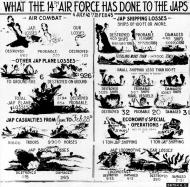
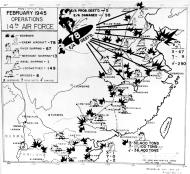
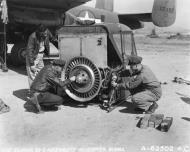
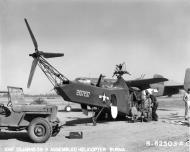


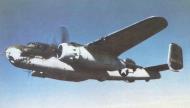

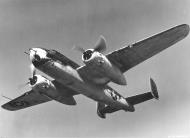

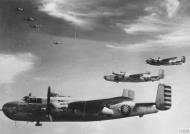
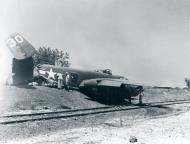
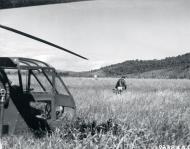
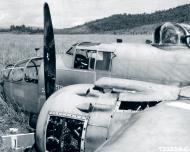
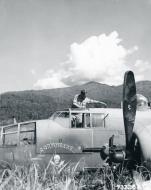
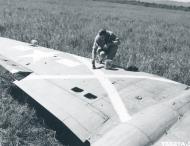
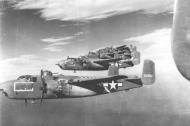

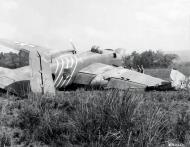
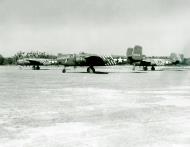
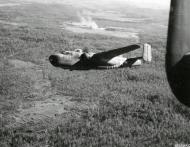



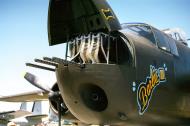
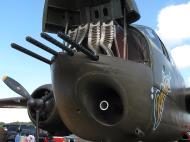
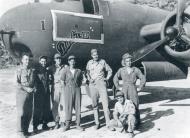

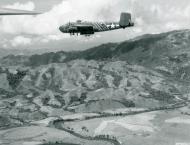
-on-line-at-Chittagong-India-23rd-Jan-1945-NA074.jpg)
-on-line-at-Chittagong-India-23rd-Jan-1945-NA074.jpg)
